Paul van Yperen's Blog, page 313
April 3, 2017
Lucien Baroux
Comic French actor Lucien Baroux (1888-1968) started in the theatre as a stage manager. After the First World War he appeared in many operettas and comedies. From the 1930s on, he also had a long career in the French cinema.
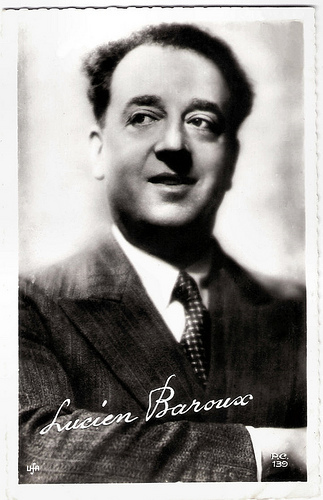
French postcard by PC, no. 139. Photo: Ufa.
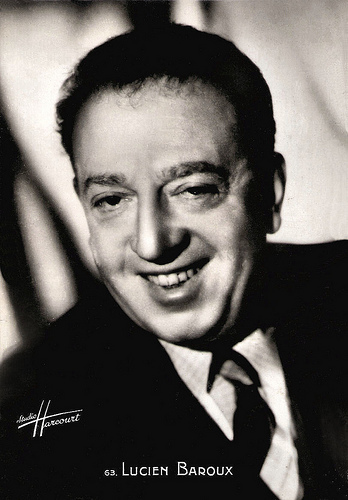
French postcard by SERP, no. 63. Photo: Studio Harcourt.
A Flair for Comedy
Lucien Baroux was born Marcel Lucien Ducros in Toulouse, France, in 1888. At his birth, he bore the name of his mother Camille Julie Ducros, because his father was unknown. Three years later, his mother married with Jules Etienne Barou who, recognised and legitimised him and the little Marcel was now called Barou.
He started his career in the theatre as a stage manager, but also appeared as an extra in many silent films of the 1910s, such as Britannicus (Camille de Morlhon, 1912).
He was a soldier during the First World War. After the war he resumed his activities as stage manager but he also launched a formidable career as an actor in both the theatre and the cinema.
He had his breakthrough when he replaced an ill actor in Souris d'hôtel. He showed a flair for comedy and became popular in musical comedies and operettas. He performed at the Théâtre Michel, and for seven years at Bouffes-Parisiens.
He also participated in the Karsenty tour for Molière’s L'École des femmes (The School for Wives) with Pierre Dux and Huguette Hue. He appeared in several popular operettas and created such unforgettable roles as Jacques Cocardier in J'adore ça (1925), Captain Harris in Passionément (1926), Dumontel in Déshabillez-vous! (1928), and Jim in Brummell (1931).
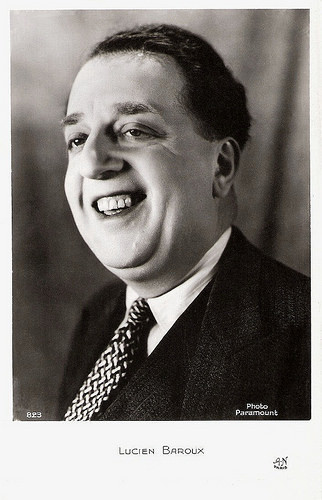
French postcard by A.N., Paris, no. 823. Photo: Paramount.
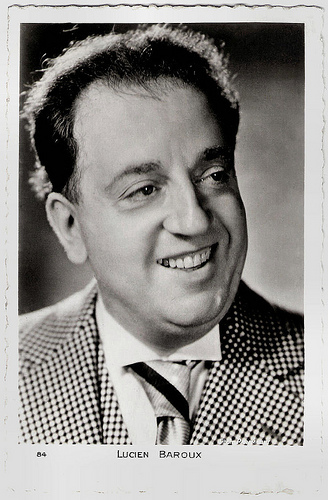
French postcard by Editions Chantal, Paris. no. 84. Photo: Paramount.
Humour and Fantasy
With his humour and fantasy, Lucien Baroux became a popular film character actor after the introduction of the sound film. He appeared as Laurent XVII in the film La Mascotte/The Mascot (Léon Mathot, 1935) and returned in the role in the 1956 recording of La Mascotte.
Among his other films of the 1930s are Tout pour l'amour/Everything for Love (Henri-Georges Clouzot, Joe May, 1933) with Jan Kiepura , and Derrière la façade/Behind the facade (Georges Lacombe, Yves Mirande, 1939).
Until 1962, he appeared in more than 80 films, including Valse brillante/Brilliant Waltz (Jean Boyer, 1949) with Marta Eggerth and Jan Kiepura , and Napoléon (Sacha Guitry, 1955).
His final film was Le Diable et les Dix Commandements/The Devil and the Ten Commandments (Julien Duvivier, 1962) in which he made a picturesque tandem with Michel Simon .
In 1964, Lucien Baroux took part in the complete recording of Le Malade imaginaire (The Imaginary Invalid) by Molière on L'Encyclopédie Sonore Hachette. He played Monsieur Diafoirus opposite Michel Galabru .
Lucien Baroux died in 1968 in Hossegro, France.
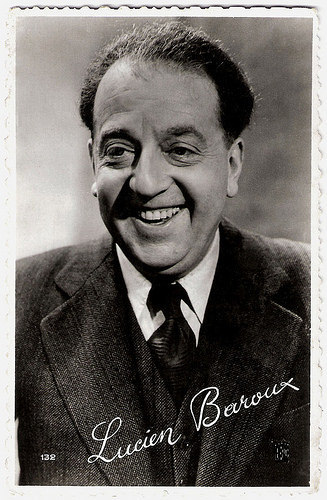
French postcard by EPC. no. 132.
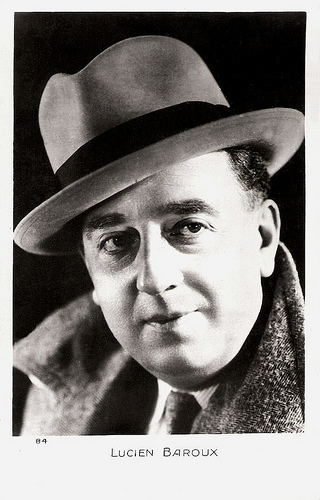
French postcard, no. 84.
Sources: Wikipedia (English and French) and .

French postcard by PC, no. 139. Photo: Ufa.

French postcard by SERP, no. 63. Photo: Studio Harcourt.
A Flair for Comedy
Lucien Baroux was born Marcel Lucien Ducros in Toulouse, France, in 1888. At his birth, he bore the name of his mother Camille Julie Ducros, because his father was unknown. Three years later, his mother married with Jules Etienne Barou who, recognised and legitimised him and the little Marcel was now called Barou.
He started his career in the theatre as a stage manager, but also appeared as an extra in many silent films of the 1910s, such as Britannicus (Camille de Morlhon, 1912).
He was a soldier during the First World War. After the war he resumed his activities as stage manager but he also launched a formidable career as an actor in both the theatre and the cinema.
He had his breakthrough when he replaced an ill actor in Souris d'hôtel. He showed a flair for comedy and became popular in musical comedies and operettas. He performed at the Théâtre Michel, and for seven years at Bouffes-Parisiens.
He also participated in the Karsenty tour for Molière’s L'École des femmes (The School for Wives) with Pierre Dux and Huguette Hue. He appeared in several popular operettas and created such unforgettable roles as Jacques Cocardier in J'adore ça (1925), Captain Harris in Passionément (1926), Dumontel in Déshabillez-vous! (1928), and Jim in Brummell (1931).

French postcard by A.N., Paris, no. 823. Photo: Paramount.

French postcard by Editions Chantal, Paris. no. 84. Photo: Paramount.
Humour and Fantasy
With his humour and fantasy, Lucien Baroux became a popular film character actor after the introduction of the sound film. He appeared as Laurent XVII in the film La Mascotte/The Mascot (Léon Mathot, 1935) and returned in the role in the 1956 recording of La Mascotte.
Among his other films of the 1930s are Tout pour l'amour/Everything for Love (Henri-Georges Clouzot, Joe May, 1933) with Jan Kiepura , and Derrière la façade/Behind the facade (Georges Lacombe, Yves Mirande, 1939).
Until 1962, he appeared in more than 80 films, including Valse brillante/Brilliant Waltz (Jean Boyer, 1949) with Marta Eggerth and Jan Kiepura , and Napoléon (Sacha Guitry, 1955).
His final film was Le Diable et les Dix Commandements/The Devil and the Ten Commandments (Julien Duvivier, 1962) in which he made a picturesque tandem with Michel Simon .
In 1964, Lucien Baroux took part in the complete recording of Le Malade imaginaire (The Imaginary Invalid) by Molière on L'Encyclopédie Sonore Hachette. He played Monsieur Diafoirus opposite Michel Galabru .
Lucien Baroux died in 1968 in Hossegro, France.

French postcard by EPC. no. 132.

French postcard, no. 84.
Sources: Wikipedia (English and French) and .
Published on April 03, 2017 22:00
April 2, 2017
Maruschka Detmers
Gorgeous Dutch actress Maruschka Detmers (1962) moved to France as a teenager, where she captured the attention of director Jean-Luc Godard, and made her dramatic debut in his Prénom Carmen (1983). Other noteworthy films include Hanna's War (1988) and The Mambo Kings (1992), but she is best known for her role in Diavolo in corpo/Devil in the Flesh (1986).
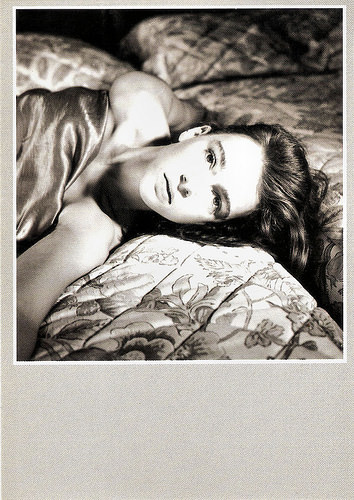
French postcard in the Le jour se lève series by Editions Humour à la carte, Paris, no. ST-19. Photo: Jean-Pierre Larcher.
Godard
Maruschka Detmers was born in 1962 in Schoonebeek, The Netherlands. Her father was a veterinarian. As a 17-year-old, she moved to Paris to work there as an au pair and take acting lessons.
In Paris, she was discovered by the French film director Jean-Luc Godard, after which she played the female lead in his film Prénom Carmen/First Name - Carmen (Jean-Luc Godard, 1983), very loosely based on Bizet's opera Carmen. Prénom Carmen tells the parallel stories of a quartet rehearsing Beethoven and a group of young people robbing a bank, supposedly to get the funds to make a film.
Louis Schwartz at AllMovie : “The film is a meditation on the difficulties of youth in the 1980s, the relations between cinema and capital, and how to film the human body. Godard fills the film with carefully composed shots of bodies playing music, making love, and acting violently. His attention to bodies in First Name: Carmen makes the film's images very close to sculptures, particularly those of Rodin.” At the Venice International Film Festival, Godard was awarded the Golden Lion for his film.
In 1985, Detmers was nominated for the César for Best Supporting Actress (Meilleure actrice dans un second rôle) for La pirate/The Pirate (Jacques Doillon, 1984) starring Jane Birkin .
The following year, Detmers starred in the Italian erotic drama Diavolo in corpo/Devil in the Flesh (1986) directed by Marco Bellocchio. An adaptation of Raymond Radiguet’s novel Le Diable au corps, the film stars Federico Pitzalis as a high school student who falls in love with an older woman (Detmers). The film caused a fuss because of a darkly-lit but explicit fellatio-scene of which the authenticity later was disputed. The film was released in the United States in both R and X-rated versions.
Also controversial was Marco Ferreri’s satirical comedy Y'a Bon Les Blancs/Um, Good, De White Folks (1988), in which members of a European humanitarian organization in African end up being eaten by cannibals.
More commercial was her leading role as Hannah Senesh, a real-life Hungarian Jew who became a martyr to the cause of freedom during WW II, in Hanna's War (Menahem Golan, 1988), produced by the Cannon Group. Hal Erickson at AllMovie : “The script, based on Hannah's diaries (as edited by Yoel Palgi), surprisingly downplays heroics in favor of sensationalism; the prison scenes could just as well have been lifted from a Linda Blair "babes behind bars" picture. Even so, Detmers is excellent in the title role, while Ellen Burstyn is likewise superb as Hannah's mother.”
French trailer La pirate/The Pirate (1984). Source: imineo Bandes Annonces (YouTube).
Genuine feeling and sensitivity
Maruschka Detmers continued her career in French, Italian and American productions. In the romantic comedy Deux/Two (Claude Zidi, 1988), she played opposite Gérard Depardieu . James Travers at Films de France : “Most of the weaknesses in the script are well-concealed by Zidi’s focused and expressive direction, and by the well-judged performances by Depardieu and Detmers. The two actors bring genuine feeling and sensitivity to their portrayals.”
Other French films include Comedie d'ete/Summer Interlude (Daniel Vigne, 1989), and Le brasier (Eric Barbier, 1991) with Jean-Marc Barr and Thierry Fortineau. The latter, a drama about the social struggles of a mining area in the 1930s, was a commercial disaster, selling less than 40,000 tickets in the Paris region. However, Detmers fell in love with co-star Thierry Fortineau and from their relationship daughter Jade Fortineau was born in 1991.
Detmers’s best known American film is the musical drama The Mambo Kings (Arne Glimcher, 1992), starring Antonio Banderas and Armand Assante. It is an adaptation of Oscar Hijuelos's 1989 Pulitzer Prize-winning novel The Mambo Kings Play Songs of Love. The film received mostly positive reviews from critics, but underperformed at the box office.
Later Detmers mostly worked in the French cinema. Her later films include Te quiero (Manuel Poirier, 2001) with Sergi López, the drama Le Père Goriot/Father Goriot (Jean-Daniel Verhaeghe, 2004), based on the novel by Honoré de Balzac and featuring Charles Aznavour , and the teen comedy Nos 18 ans/School's Out (Frédéric Berthe, 2008).
In Germany she appeared opposite Tom Schilling in the comedy Robert Zimmermann wundert sich über die Liebe/Robert Zimmermann Is Tangled Up in Love (Leander Haussmann, 2008) about a Spring-Autumn romance. Finally, she made her Dutch film debut in the comedy-drama Ventoux (Nicole van Kilsdonk, 2015). However, she now mostly works for French television, including a part in the hit series Marseille (Thomas Gilou, Florent-Emilio Siri, 2016), starring Gérard Depardieu .
Maruschka Detmers lives in Paris. Her daughter Jade Fortineau is now also an actress.
Trailer The Mambo Kings (1992). Source: Video Detective (YouTube).
Trailer Robert Zimmermann wundert sich über die Liebe/Robert Zimmermann Is Tangled Up in Love (2008). Source: Snoozercat (YouTube).
Sources: Hal Erickson (AllMovie), (AllMovie), James Travers (Films de France), AllMovie, Wikipedia (English and Dutch) and .

French postcard in the Le jour se lève series by Editions Humour à la carte, Paris, no. ST-19. Photo: Jean-Pierre Larcher.
Godard
Maruschka Detmers was born in 1962 in Schoonebeek, The Netherlands. Her father was a veterinarian. As a 17-year-old, she moved to Paris to work there as an au pair and take acting lessons.
In Paris, she was discovered by the French film director Jean-Luc Godard, after which she played the female lead in his film Prénom Carmen/First Name - Carmen (Jean-Luc Godard, 1983), very loosely based on Bizet's opera Carmen. Prénom Carmen tells the parallel stories of a quartet rehearsing Beethoven and a group of young people robbing a bank, supposedly to get the funds to make a film.
Louis Schwartz at AllMovie : “The film is a meditation on the difficulties of youth in the 1980s, the relations between cinema and capital, and how to film the human body. Godard fills the film with carefully composed shots of bodies playing music, making love, and acting violently. His attention to bodies in First Name: Carmen makes the film's images very close to sculptures, particularly those of Rodin.” At the Venice International Film Festival, Godard was awarded the Golden Lion for his film.
In 1985, Detmers was nominated for the César for Best Supporting Actress (Meilleure actrice dans un second rôle) for La pirate/The Pirate (Jacques Doillon, 1984) starring Jane Birkin .
The following year, Detmers starred in the Italian erotic drama Diavolo in corpo/Devil in the Flesh (1986) directed by Marco Bellocchio. An adaptation of Raymond Radiguet’s novel Le Diable au corps, the film stars Federico Pitzalis as a high school student who falls in love with an older woman (Detmers). The film caused a fuss because of a darkly-lit but explicit fellatio-scene of which the authenticity later was disputed. The film was released in the United States in both R and X-rated versions.
Also controversial was Marco Ferreri’s satirical comedy Y'a Bon Les Blancs/Um, Good, De White Folks (1988), in which members of a European humanitarian organization in African end up being eaten by cannibals.
More commercial was her leading role as Hannah Senesh, a real-life Hungarian Jew who became a martyr to the cause of freedom during WW II, in Hanna's War (Menahem Golan, 1988), produced by the Cannon Group. Hal Erickson at AllMovie : “The script, based on Hannah's diaries (as edited by Yoel Palgi), surprisingly downplays heroics in favor of sensationalism; the prison scenes could just as well have been lifted from a Linda Blair "babes behind bars" picture. Even so, Detmers is excellent in the title role, while Ellen Burstyn is likewise superb as Hannah's mother.”
French trailer La pirate/The Pirate (1984). Source: imineo Bandes Annonces (YouTube).
Genuine feeling and sensitivity
Maruschka Detmers continued her career in French, Italian and American productions. In the romantic comedy Deux/Two (Claude Zidi, 1988), she played opposite Gérard Depardieu . James Travers at Films de France : “Most of the weaknesses in the script are well-concealed by Zidi’s focused and expressive direction, and by the well-judged performances by Depardieu and Detmers. The two actors bring genuine feeling and sensitivity to their portrayals.”
Other French films include Comedie d'ete/Summer Interlude (Daniel Vigne, 1989), and Le brasier (Eric Barbier, 1991) with Jean-Marc Barr and Thierry Fortineau. The latter, a drama about the social struggles of a mining area in the 1930s, was a commercial disaster, selling less than 40,000 tickets in the Paris region. However, Detmers fell in love with co-star Thierry Fortineau and from their relationship daughter Jade Fortineau was born in 1991.
Detmers’s best known American film is the musical drama The Mambo Kings (Arne Glimcher, 1992), starring Antonio Banderas and Armand Assante. It is an adaptation of Oscar Hijuelos's 1989 Pulitzer Prize-winning novel The Mambo Kings Play Songs of Love. The film received mostly positive reviews from critics, but underperformed at the box office.
Later Detmers mostly worked in the French cinema. Her later films include Te quiero (Manuel Poirier, 2001) with Sergi López, the drama Le Père Goriot/Father Goriot (Jean-Daniel Verhaeghe, 2004), based on the novel by Honoré de Balzac and featuring Charles Aznavour , and the teen comedy Nos 18 ans/School's Out (Frédéric Berthe, 2008).
In Germany she appeared opposite Tom Schilling in the comedy Robert Zimmermann wundert sich über die Liebe/Robert Zimmermann Is Tangled Up in Love (Leander Haussmann, 2008) about a Spring-Autumn romance. Finally, she made her Dutch film debut in the comedy-drama Ventoux (Nicole van Kilsdonk, 2015). However, she now mostly works for French television, including a part in the hit series Marseille (Thomas Gilou, Florent-Emilio Siri, 2016), starring Gérard Depardieu .
Maruschka Detmers lives in Paris. Her daughter Jade Fortineau is now also an actress.
Trailer The Mambo Kings (1992). Source: Video Detective (YouTube).
Trailer Robert Zimmermann wundert sich über die Liebe/Robert Zimmermann Is Tangled Up in Love (2008). Source: Snoozercat (YouTube).
Sources: Hal Erickson (AllMovie), (AllMovie), James Travers (Films de France), AllMovie, Wikipedia (English and Dutch) and .
Published on April 02, 2017 22:00
April 1, 2017
Imported from the USA: Tina Louise
American actress, singer, and author Tina Louise (1934) began her career on stage during mid-1950s and became a popular pin-up model, before landing her breakthrough role in the film drama God's Little Acre (1958). She received the Golden Globe for New Star of the Year and landed starring roles in Hollywood movies, like The Trap (1959), The Hangman (1959), and For Those Who Think Young (1964), and several Italian films. She is now best remembered for the TV comedy series Gilligan's Island (1964-1967).
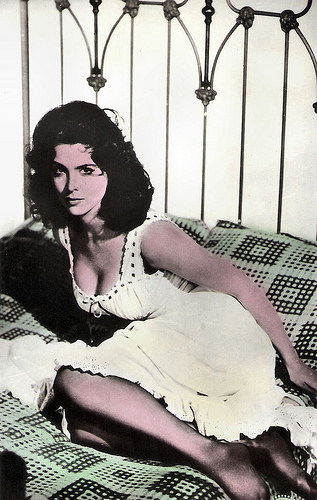
Yugoslavian postcard by Studio Sombor. Photo: publicity still for The Trap (Norman Panama, 1959).
It's Time for Tina
Tina Louise was born Tina Blacker in 1934 in New York City. An only child, she was raised by her mother, Betty Horn (born Myers) Blacker, a fashion model. Tina's father, Joseph Blacker, was a candy store owner in Brooklyn and later an accountant.
Only two years old, Tina got her first role, after being seen in an ad for her father's candy store. She played numerous roles until she decided it was best to focus on school work. The name ‘Louise’ was allegedly added during her senior year in high school when she mentioned to her drama teacher that she was the only girl in the class without a middle name. He selected the name ‘Louise’ and it stuck.
Tina Louise attended Miami University in Ohio. By the age of 17, she began studying acting, singing and dancing. She studied acting under Sanford Meisner at the prestigious Neighbourhood Playhouse in Manhattan.
Her acting debut came in 1952 in the Bette Davis musical revue Two's Company, followed by roles in other Broadway productions, such as John Murray Anderson's Almanac (1953) with Harry Belafonte, The Fifth Season (1953), and Will Success Spoil Rock Hunter? (1955).
She appeared in such early live television dramas as Studio One (1956), Producers' Showcase (1956), and Appointment with Adventure. In 1957, she appeared on Broadway in the hit musical Li'l Abner, based on the famous comic strip character created by Al Capp. Her album, It's Time for Tina, was released that year, with songs such as Embraceable You and I'm in the Mood for Love.
During her early acting years, she was offered modelling jobs, including as a rising starlet, who along with Jayne Mansfield , was a product advocate in the 1958 Frederick's of Hollywood catalogue, and appeared on the cover of several pinup magazines such as Adam, Sir! and Modern Man. Her later pictorials for Playboy (May 1958; April 1959) were arranged by Columbia Pictures studio in an effort to further promote the young actress.

French postcard by Editions P.I., Paris, no. 997. Presented by Les Carbones Korès 'Carboplane'. Photo: Paramount. Publicity still for The Trap (Norman Panama, 1959).
Viva l'Italia!
In 1958, Tina Louise made her Hollywood film debut in God's Little Acre (Anthony Mann, 1958), based on Erskine Caldwell's 1933 novel of the same name. The film was an entry in the Venice Film Festival.
She became an in-demand leading lady for major stars like Robert Taylor in The Hangman (Michael Curtiz, 1959), Richard Widmark in The Trap (Norman Panama, 1959), and Robert Ryan in Day of the Outlaw (André de Toth, 1959).
She often played sombre roles quite unlike the glamorous pin-up photographs she had become famous for in the late 1950s. She turned down roles in Li'l Abner and Operation Petticoat taking roles in the Italian cinema.
She starred opposite Rossano Brazzi and Sylva Koscina in the historical drama L'assedio di Siracusa/Siege of Syracuse (Pietro Francisci, 1960), about the Roman Siege of Syracuse, which took place between 214 and 212 B.C., during the Second Punic War with Carthage.
Among her other notable Italian film credits was the historical epic Viva l'Italia!/Garibaldi (1960), directed by Roberto Rossellini, that concerned Italy's historic national hero Garibaldi's ( Renzo Ricci ) efforts to unify the Italian states in 1860.
When Louise returned to the United States, she began studying with Lee Strasberg and eventually became a member of the Actors Studio. She appeared in a 1962 episode of The Real McCoys, the Walter Brennan sitcom, and in the beach party film For Those Who Think Young (Leslie H. Martinson, 1964), with Bob Denver, prior to the development of Gilligan's Island.
In 1964, she co-starred with Carol Burnett in the Broadway musical Fade Out – Fade In. She left the musical to portray movie star Ginger Grant on the situation comedy Gilligan's Island (1964-1967), after the part was turned down by Jayne Mansfield . The role did make Louise a pop icon of the era, and one of the greatest of television's all-time sex symbols.
However, Louise was unhappy with the role and worried that it would typecast her. After the series ended in 1967, she continued to work in film and made numerous guest appearances in various television series. She appeared in the Matt Helm spy spoof The Wrecking Crew (Phil Karlson, 1969) with Dean Martin and Elke Sommer . Louise played a doomed suburban housewife in the original The Stepford Wives (Bryan Forbes, 1975), and both the film and her performance were well received.
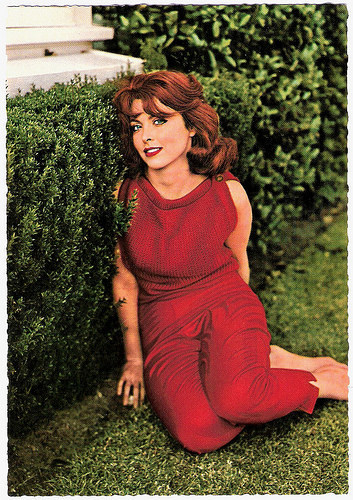
German postcard by Krüger, no. 902/63.
Grittier roles
Tina Louise attempted to shed her comedic image by assaying grittier roles, including a guest appearance as a heroin addict in an episode of the TV series Kojak (1974), as well as a co-starring role as an Southern prison guard in the women-in-prison TV movie Nightmare in Badham County (John Llewellyn Moxey, 1976). Her other television films of the period included Look What's Happened to Rosemary's Baby (Sam ‘O Steen, 1976), SST: Death Flight (David Lowell Rich, 1977), and Friendships, Secrets and Lies (Marlene Laird, Ann Zane Shanks, 1979).
She played J.R. Ewing's secretary on the first season of the legendary soap opera Dallas (1978–1979). Her character was finally killed off. In France, she appeared in the crime film Canicule/Dog Day (Yves Boisset, 1984) with Lee Marvin and Miou-Miou. In the fall of 1984, she replaced Jo Ann Pflug as Taylor Chapin on the syndicated soap opera Rituals after Pflug refused to do love scenes with co-star George Lazenby due to her religious beliefs. After a few months, however, Louise did not renew her own contract and the character was written out.
She later made cameo appearances on the network daytime soaps Santa Barbara and All My Children. Louise declined to participate in any of the three reunion television films for Gilligan's Island. Despite maintaining an adequate career after the show's run, she kept claiming that the show actually ruined her career. The role of Ginger was recast with Judith Baldwin and Constance Forslund.
Although she did not appear in these television movies, she made brief walk-on appearances on a few talk shows and specials for Gilligan's Island reunions, including Good Morning America (1982), The Late Show (1988) and the TV Land award show (2004) with the other surviving cast members.
Wikipedia : “In the 1990s, she was reunited with costars Bob Denver, Dawn Wells, and Russell Johnson in an episode of Roseanne. She did not reunite with them for the television film Surviving Gilligan's Island (2001), co-produced by Wells. She was portrayed by Kristen Dalton in the television film. Her relations with series star Denver were rumoured to be strained, but in 2005, she wrote a brief, affectionate memorial to him in the year-end farewell issue of Entertainment Weekly.
Later film roles included a co-starring appearance in the Robert Altman comedy O.C. and Stiggs (1987) as well as the award winning satire Johnny Suede (Tom DiCillo, 1992) starring Brad Pitt , and the Australian comedy Welcome to Woop Woop (Stephan Elliott, 1997) starring Johnathon Schaech and Rod Taylor. In 2014 she appeared in the horror film Late Phases by Spanish director Adrián García Bogliano, in which a blind war veteran becomes the victim of a werewolf attack.
From 1966 to 1974, Tina Louise was married to radio and TV announcer/interviewer Les Crane, with whom she has one daughter, Caprice Crane (born 1970), who became an MTV producer and a novelist. Tina Louise now resides in New York City. She has written three books including Sunday: A Memoir (1997) and the children’s books When I Grow Up (2007) and What Does a Bee Do? (2009). Tina Louise lived in New York.
Tina Louise dances in L'assedio di Siracusa/Siege of Syracuse (1960). Source: galesayers (YouTube).
Trailer Late Phases (2014). Source: Light Movies (YouTube).
Sources: Wikipedia and .

Yugoslavian postcard by Studio Sombor. Photo: publicity still for The Trap (Norman Panama, 1959).
It's Time for Tina
Tina Louise was born Tina Blacker in 1934 in New York City. An only child, she was raised by her mother, Betty Horn (born Myers) Blacker, a fashion model. Tina's father, Joseph Blacker, was a candy store owner in Brooklyn and later an accountant.
Only two years old, Tina got her first role, after being seen in an ad for her father's candy store. She played numerous roles until she decided it was best to focus on school work. The name ‘Louise’ was allegedly added during her senior year in high school when she mentioned to her drama teacher that she was the only girl in the class without a middle name. He selected the name ‘Louise’ and it stuck.
Tina Louise attended Miami University in Ohio. By the age of 17, she began studying acting, singing and dancing. She studied acting under Sanford Meisner at the prestigious Neighbourhood Playhouse in Manhattan.
Her acting debut came in 1952 in the Bette Davis musical revue Two's Company, followed by roles in other Broadway productions, such as John Murray Anderson's Almanac (1953) with Harry Belafonte, The Fifth Season (1953), and Will Success Spoil Rock Hunter? (1955).
She appeared in such early live television dramas as Studio One (1956), Producers' Showcase (1956), and Appointment with Adventure. In 1957, she appeared on Broadway in the hit musical Li'l Abner, based on the famous comic strip character created by Al Capp. Her album, It's Time for Tina, was released that year, with songs such as Embraceable You and I'm in the Mood for Love.
During her early acting years, she was offered modelling jobs, including as a rising starlet, who along with Jayne Mansfield , was a product advocate in the 1958 Frederick's of Hollywood catalogue, and appeared on the cover of several pinup magazines such as Adam, Sir! and Modern Man. Her later pictorials for Playboy (May 1958; April 1959) were arranged by Columbia Pictures studio in an effort to further promote the young actress.

French postcard by Editions P.I., Paris, no. 997. Presented by Les Carbones Korès 'Carboplane'. Photo: Paramount. Publicity still for The Trap (Norman Panama, 1959).
Viva l'Italia!
In 1958, Tina Louise made her Hollywood film debut in God's Little Acre (Anthony Mann, 1958), based on Erskine Caldwell's 1933 novel of the same name. The film was an entry in the Venice Film Festival.
She became an in-demand leading lady for major stars like Robert Taylor in The Hangman (Michael Curtiz, 1959), Richard Widmark in The Trap (Norman Panama, 1959), and Robert Ryan in Day of the Outlaw (André de Toth, 1959).
She often played sombre roles quite unlike the glamorous pin-up photographs she had become famous for in the late 1950s. She turned down roles in Li'l Abner and Operation Petticoat taking roles in the Italian cinema.
She starred opposite Rossano Brazzi and Sylva Koscina in the historical drama L'assedio di Siracusa/Siege of Syracuse (Pietro Francisci, 1960), about the Roman Siege of Syracuse, which took place between 214 and 212 B.C., during the Second Punic War with Carthage.
Among her other notable Italian film credits was the historical epic Viva l'Italia!/Garibaldi (1960), directed by Roberto Rossellini, that concerned Italy's historic national hero Garibaldi's ( Renzo Ricci ) efforts to unify the Italian states in 1860.
When Louise returned to the United States, she began studying with Lee Strasberg and eventually became a member of the Actors Studio. She appeared in a 1962 episode of The Real McCoys, the Walter Brennan sitcom, and in the beach party film For Those Who Think Young (Leslie H. Martinson, 1964), with Bob Denver, prior to the development of Gilligan's Island.
In 1964, she co-starred with Carol Burnett in the Broadway musical Fade Out – Fade In. She left the musical to portray movie star Ginger Grant on the situation comedy Gilligan's Island (1964-1967), after the part was turned down by Jayne Mansfield . The role did make Louise a pop icon of the era, and one of the greatest of television's all-time sex symbols.
However, Louise was unhappy with the role and worried that it would typecast her. After the series ended in 1967, she continued to work in film and made numerous guest appearances in various television series. She appeared in the Matt Helm spy spoof The Wrecking Crew (Phil Karlson, 1969) with Dean Martin and Elke Sommer . Louise played a doomed suburban housewife in the original The Stepford Wives (Bryan Forbes, 1975), and both the film and her performance were well received.

German postcard by Krüger, no. 902/63.
Grittier roles
Tina Louise attempted to shed her comedic image by assaying grittier roles, including a guest appearance as a heroin addict in an episode of the TV series Kojak (1974), as well as a co-starring role as an Southern prison guard in the women-in-prison TV movie Nightmare in Badham County (John Llewellyn Moxey, 1976). Her other television films of the period included Look What's Happened to Rosemary's Baby (Sam ‘O Steen, 1976), SST: Death Flight (David Lowell Rich, 1977), and Friendships, Secrets and Lies (Marlene Laird, Ann Zane Shanks, 1979).
She played J.R. Ewing's secretary on the first season of the legendary soap opera Dallas (1978–1979). Her character was finally killed off. In France, she appeared in the crime film Canicule/Dog Day (Yves Boisset, 1984) with Lee Marvin and Miou-Miou. In the fall of 1984, she replaced Jo Ann Pflug as Taylor Chapin on the syndicated soap opera Rituals after Pflug refused to do love scenes with co-star George Lazenby due to her religious beliefs. After a few months, however, Louise did not renew her own contract and the character was written out.
She later made cameo appearances on the network daytime soaps Santa Barbara and All My Children. Louise declined to participate in any of the three reunion television films for Gilligan's Island. Despite maintaining an adequate career after the show's run, she kept claiming that the show actually ruined her career. The role of Ginger was recast with Judith Baldwin and Constance Forslund.
Although she did not appear in these television movies, she made brief walk-on appearances on a few talk shows and specials for Gilligan's Island reunions, including Good Morning America (1982), The Late Show (1988) and the TV Land award show (2004) with the other surviving cast members.
Wikipedia : “In the 1990s, she was reunited with costars Bob Denver, Dawn Wells, and Russell Johnson in an episode of Roseanne. She did not reunite with them for the television film Surviving Gilligan's Island (2001), co-produced by Wells. She was portrayed by Kristen Dalton in the television film. Her relations with series star Denver were rumoured to be strained, but in 2005, she wrote a brief, affectionate memorial to him in the year-end farewell issue of Entertainment Weekly.
Later film roles included a co-starring appearance in the Robert Altman comedy O.C. and Stiggs (1987) as well as the award winning satire Johnny Suede (Tom DiCillo, 1992) starring Brad Pitt , and the Australian comedy Welcome to Woop Woop (Stephan Elliott, 1997) starring Johnathon Schaech and Rod Taylor. In 2014 she appeared in the horror film Late Phases by Spanish director Adrián García Bogliano, in which a blind war veteran becomes the victim of a werewolf attack.
From 1966 to 1974, Tina Louise was married to radio and TV announcer/interviewer Les Crane, with whom she has one daughter, Caprice Crane (born 1970), who became an MTV producer and a novelist. Tina Louise now resides in New York City. She has written three books including Sunday: A Memoir (1997) and the children’s books When I Grow Up (2007) and What Does a Bee Do? (2009). Tina Louise lived in New York.
Tina Louise dances in L'assedio di Siracusa/Siege of Syracuse (1960). Source: galesayers (YouTube).
Trailer Late Phases (2014). Source: Light Movies (YouTube).
Sources: Wikipedia and .
Published on April 01, 2017 22:00
March 31, 2017
Wanna Be Marilyn
At 5 March, there was a carte blanche guest post by my friend, collector Carla Bosch (a.k.a. Meiter). She did a wonderful post on her collection of Marilyn Monroe postcards, Collecting Marilyn. While researching her post, Carla discovered many Marilyn wannabes:
"In my list of favourite old Marilyn cards, I said it would be a nice idea to make a list with Marilyn wannabes, lookalikes, or clones. Bob thought this a nice idea too, so I set to work. I did not realise what kind of trouble I brought upon myself. There are people who wanted to look like her, people who were compared to her, but didn't want to. Even now famous people try to imitate Marilyn.
There are many lists to be found on the internet with Marilyn wannabes. Some of those surprised me: for example Mariah Carey. She is not one who first comes to mind when you think of Marilyn. I read Mariah bought Marilyn's white baby grand piano and named one of her children after her. Okay, that does not make her Marilyn yet. And then I saw a picture with Mariah Carey imitating Marilyn Monroe when she climbs out of the swimming pool in Something's gotta give. I was dumbfounded: Mariah is Marilyn.
Another actress whom I thought a surprise is Michelle Williams. To be honest, I only knew her as the wife of Heath Ledger in Broke Back Mountain and his fiance in real life. But then I saw her in My Week with Marilyn. I was impressed. I have respect for Michelle as an actress since that movie.
I also came across socialite Paris Hilton. She thinks she is the iconic blonde of this century, like Marilyn Monroe was of her century. Hmm. Paris thinks she is a lot of things: a singer, a dj, a business woman, even an actress, but Marilyn.....? No way.
There are many photo shoots with famous actresses posing as Marilyn Monroe. Famous is Lindsay Lohan posing nude as Marilyn Monroe in her last sitting. Bert Stern took those world famous pictures all over again. I am not impressed by Lindsay Lohan. But another comparison entered my mind: Marilyn and Lindsay both had / have trouble dealing with the film industry resulting in on and off addictions to drugs and alcohol. Lindsay said she has no intention to follow Marilyn Monroe or Heath Ledger. Yes, the same Heath Ledger as Michelle Williams' fiance, Hollywood is a small world.
Other photo shoots I found were with Scarlett Johansson, Mira Sorvino, Christina Aguilera, Gwen Stefani. Even Angelina Jolie and Nicole Kidman posed as Marilyn. One of the most famous Marilyn imitators is Madonna. I will come to her later, because I actually have cards of Madonna in my collection.
Let it suffice that many people want to look like Marilyn Monroe and try to build a career around her image. I decided to restrict the list to cards I have in my collection:
1. Mamie van Doren
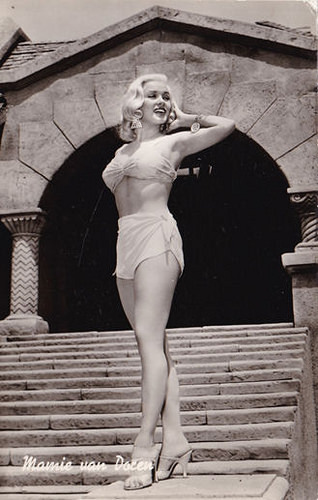
German postcard by Bild und Ton, Postkartenverlag P. Weizmann, no. 546. Collection: Meiter.
When Marilyn Monroe rose to fame in the fifties, the 'blonde bombshell' was born. Every film studio wanted to have their own blonde bombshell. Mamie van Doren , Jayne Mansfield and Marilyn Monroe : 'The Three M's' were the most famous. Mamie van Doren was promoted as 'the next Marilyn' by Universal Studios. She starred in some movies and acquired a reputation as 'bad girl'. She became famous for her tight sweaters, swimming suits, and low-cut cleavage. She even spent a short time in prison because her naked back could be seen in a shower scene in Girls Town (1959). After her career she could still cash in on her sex bomb image (indirectly Marilyn's) and published an autobiography, posed with Baywatch babe Pamela Anderson for Vanity Fair, and now and again appeared in TV programmes and (low budget) films. Mamie is still alive and kicking. She maintains, together with her 5th husband, her website where various merchandise can be obtained.
2. Jayne Mansfield
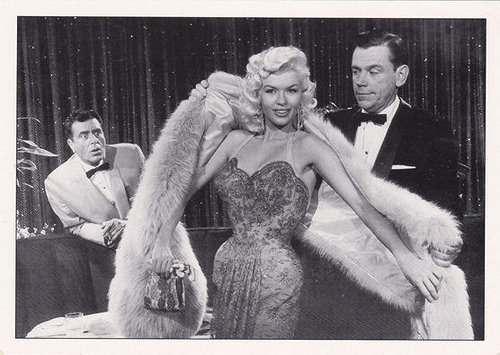
French postcard by Edition A La Carte. Photo: Filmhistorisches Bildarchiv Peter W. Engelmeier. Collection: Meiter.
Jayne Mansfield was also known as 'The Poor Man's Monroe'. In 1956 Mamie van Doren turned down a role in Will Success Spoil Rock Hunter (by the way, I possess a paperback which is called Will Acting Spoil Marilyn Monroe by Pete Martin...with 43 luscious pictures which clearly prove that NOTHING could spoil Marilyn) and was replaced by rival-blonde Jayne Mansfield . The card I have chosen of her is a modern one: Jayne Mansfield and Tom Ewell in The Girl Can't Help It, 1956. The comparison is obvious: Jayne looks like a spitting image of Marilyn. Tom Ewell played with Marilyn in The Seven Year Itch in 1955. Jayne auditioned for a role in The Seven Year Itch, but was rejected. For The Girl Can't Help It, Fox promoted Mansfield as “Marilyn Monroe king-sized”. She was never able to get rid of this image, a sexy woman with little brains. Marilyn's hips were considered too broad to pursue a modelling career. Jayne Mansfield 's breasts were too emphatically promoted to be considered a serious actress. A pity: both had more potential than breasts and hips.
3. Diana Dors
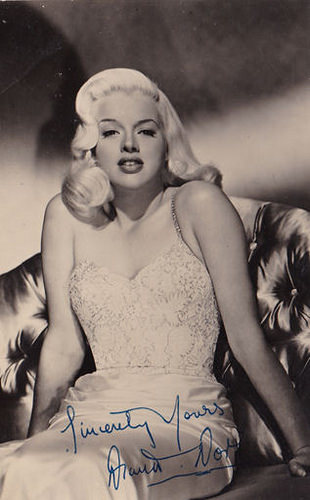
British postcard. Photo: Rank. Collection: Meiter.
Diana Dors was referred to as 'the English Marilyn Monroe'. She did not like that comparison. She wanted to be appreciated and remembered for her acting career. Marilyn wanted the same thing. Yet, Diana Dors is not only remembered because of her film career. (I somewhere read she played in some of the worst films ever made). She is also remembered because of her tumultuous private life: her three marriages, numerous affairs, and the sex parties she hosted. Marilyn was an icon when she was alive, Britain realised 'their' Diana was one after she died. Yet, Marilyn was trendsetter as a bombshell: Marilyn led, others followed. Mamie van Doren , Barbara Nichols, Cleo Moore, Jayne Mansfield , Sabrina (Norma Ann Sykes), Sandra Dorne , Diana Dors , and many other actresses: they all copied Marilyn's clothes, her hair-do, make-up styles, her poses. All 'clones' struggled to be taken seriously as actresses and they all had their moment of fame. Later on, however, most of them had difficulties maintaining this status and often did not get rid of the sex bomb image.
4. Jester Naefe
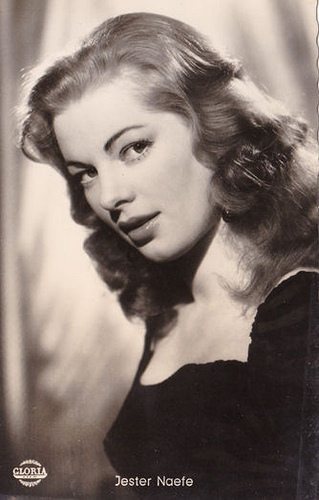
German postcard by Kolibri Verlag, no. 1954. Photo: publicity still for Die goldene Brücke/The Golden Bridge (Paul Verhoeven, 1956). Collection: Meiter.
Jester Naefe was called 'The German Marilyn Monroe'. Gregory Peck called her one of the most attractive and beautiful women in the world. I think she looks like the young Marilyn. Before Marilyn started to dye her hair blonde, she was a redhead. There is a German postcard which I do not have in my possession, but which is on EFSP ; it looks like this card, but then Jester is …. a redhead, a young Marilyn. Jester Naefe did not have to dye her hair. She made a career as an actress, but had to give it up because of her disease multiple sclerosis. She died after an aggressive progression of it. I think that is why I have a weak spot for Jester: I have m.s. too. Or is that too personal?
5. Brigitte Bardot
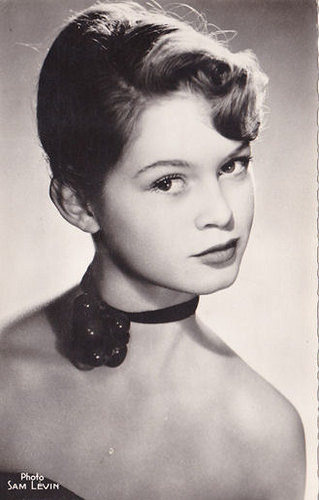
French postcard by Edition du Globe, no. 316. Collection: Meiter.
The French answer to MM was BB. She was one of the few European actresses who were popular in the United States. The term 'sex kitten' was for the first time used to describe Brigitte Bardot . Later on, this term was used to describe other sexually provocative actresses. I saw an interview with BB in which she talks about Marilyn. She has only positive things to say about her: she thought Marilyn was beautiful, sexy, funny, but also vulnerable. She said Marilyn was misunderstood and being exploited. And this combination eventually killed her. The postcard I chose is one with a young Brigitte Bardot . The picture was taken by Sam Levin . Levin contributed to BB's sensual image in the beginning of her career. I think this is such an example: a very young Brigitte looking coyly, yet also cheeky in the camera. And this might be armchair psychology, but I think Brigitte Bardot realised in time how devastating the influence of the film world could be. She herself attempted suicide in 1960, and after first announcing she would retire, made her last film in 1973 when she was 39. Sensible girl.
6. Jeanne Moreau
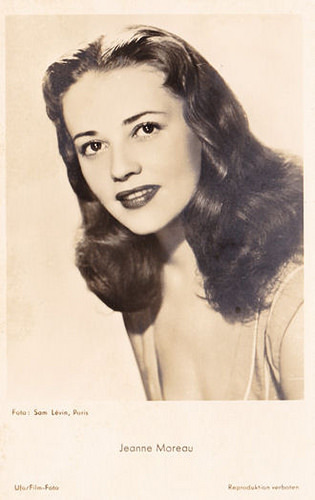
German postcard by Universum-Film AG, no. FK 1015. Collection: Meiter.
A 'misfit' in this list is Jeanne Moreau . There is nothing to connect Moreau and Monroe. Moreau is one of France's most accomplished actresses. At the start of her career she appeared in some B-movies and was not considered photogenic, because she refused to wear make up. No make up? Marilyn could not go without. Yet, I picked Jeanne Moreau , because I chose a postcard of her in my first list as one of my favourites. It reminds me of a picture that Marilyn had taken as 'prom-photo'. When I went through my cards looking for Marilyn lookalikes I came across another card of Jeanne: again I was struck by the resemblance to a young Marilyn. And again: I know there could not be two more different actresses and I cannot find any similarities, apart from being both actresses. So Moreau is absolutely not a wannabe lookalike of Monroe, yet those postcards! They do remind me very much of Marilyn.
7. Grace Kelly
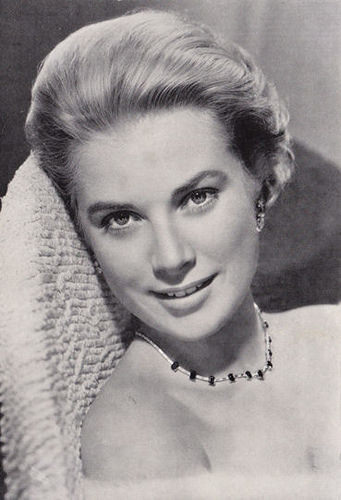
German postcard by WS-Druck, Wanne-Eickel, no. 278. Collection: Meiter.
Once upon a time there was a prince: Rainier, Prince of Monaco. Monaco was in a poor state and Rainier was considered to be a spoilt playboy prince who loved fast cars and pretty women. However, he decided to modernise the country and did so with the help of his friend, the rich Greek shipping tycoon Aristotle Onassis. When Monaco became prosperous again, Aristotle decided it was time for Rainier to marry. Preferably a glamorous American actress: this would create a bond with one of the most powerful countries and wealthy industries in the world. Onassis suggested.... Marilyn Monroe . They sent her a letter. Marilyn found it an amusing idea and referred to Rainier as “Prince Reindeer”. She declined the proposal, because she had just started dating Arthur Miller and wanted to be respected as an actress. That is the reason why Grace Kelly has to be in this list. Marilyn was not a princess, Grace Kelly was. The day Grace married Rainier, Marilyn sent her a telegram to congratulate her that she “had found a way out of this business”. Apparently this was not the way Marilyn had in mind.
And now for the more modern cards and stars. As I said, I don't have too many of those, but here are two:
8. Kylie Minogue
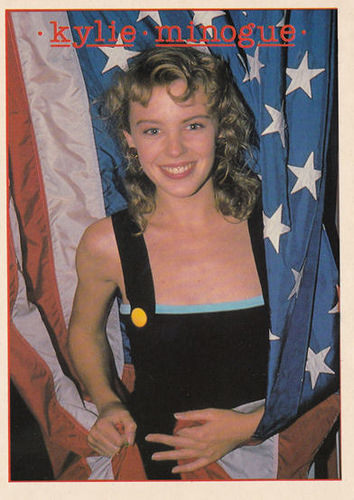
British postcard by Heroes, no. SPC1069. Collection: Meiter.
Australian singer Kylie Minogue is not one to imitate or who wants to look like Marilyn. She was, however, one of the artists who imitated Marilyn and playbacked (nobody could match Marilyn singing, so Kylie had to playback) Diamonds Are A Girl's Best Friend on the little Marilyn Monroe 's tribute show at the celebration of Fox Sudios, Australia. Her latest album Kiss Me Once has pictures that do remind of Marilyn. On the deluxe version, there is a picture of Kylie Minogue posing on the beach. She is dressed in a pink fifties-style dress, wearing a blonde wig. She posted the picture on Instagram with the hashtag 'Mr. President'... There are more pictures of Kylie looking like Marilyn. Yet, I do not have the impression it was all predetermined. Kylie Minogue just resembles Marilyn Monroe unintentionally and unwillingly.
9. Madonna
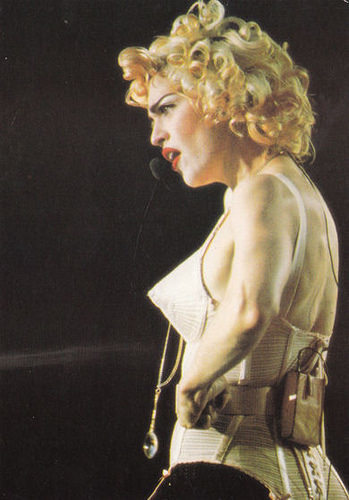
Italian postcard by Modric Editoria D'Arte, no. MX 022. Marilyn Monroe as Lilian Russell. Collection: Meiter.
Madonna, however, is quite a different story. She grew up idolising Marilyn and built her entire career round her image. She blonded her hair, drew a beauty spot near her mouth, and as a publicity stunt she even dated John F. Kennedy Jr. She re-enacted Marilyn's Diamonds are a Girl's Best Friend in the clip for Material Girl, imitating her hairstyle, mannerisms and outfits. In fact, Madonna's entire Blond Ambition Tour was built round Marilyn's range of appearances. As this postcard shows Madonna is a different Marilyn: compared to Marilyn, Madonna is crude. One of Marilyn's best known scenes is when she stands above a subway grating and her dress goes up. This was a box office hit. Madonna tried to match this image by using rude language, making provocative video clips, spreading her legs when posing for advertisements. Yes, they are both icons in their own way. And it probably has something to do with the zeitgeist, but Madonna is a rather vulgar version of Marilyn and is still overshadowed by her.
10. Marilyn as Lillian Russell
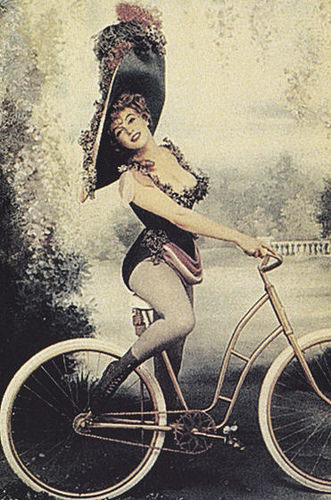
Italian postcard by Modric Editoria D'Arte, no. MX 022. Marilyn Monroe as Lilian Russell. Collection: Meiter.
Finally: Marilyn was / is imitated by admirers, lookalikes, wannabes, and parasites. Yet Marilyn herself imitated astonishingly well too. In 1957 Richard Avedon made a photo shoot with her. Marilyn imitated 5 famous sexy women: Jean Harlow, Clara Bow, Theda Bara, Marlene Dietrich , and Lillian Russell. The only postcard I have in my possession is the one with Marilyn as Lillian Russell (I doubt whether there are postcards of the other imitations).
Lillian Russell was a famous actress and singer in the late 19th and early 20th centuries. She starred in operettas, burlesques, even a few motion pictures. She was also known for her beauty and social life. When she was older she became a popular lecturer, a campaigner for women's suffrage, and contributor to the passage of the restrictive Immigration Act of 1924 (which would indirectly led to her death in 1922). All I can say is that I don't know Lillian, but from the pictures I have seen, she was a very attractive woman with an expressive face. Marilyn makes a perfect Lillian Russell. There was more to Marilyn than just Marilyn Monroe .
And that is my list. Again, I loved the reading and searching for information. I came across postcards in my collection I did not realise were there. They remain a treasure. My treasure. Pff, enough!"
Thank you very much, Carla, for this delicious fun post!
"In my list of favourite old Marilyn cards, I said it would be a nice idea to make a list with Marilyn wannabes, lookalikes, or clones. Bob thought this a nice idea too, so I set to work. I did not realise what kind of trouble I brought upon myself. There are people who wanted to look like her, people who were compared to her, but didn't want to. Even now famous people try to imitate Marilyn.
There are many lists to be found on the internet with Marilyn wannabes. Some of those surprised me: for example Mariah Carey. She is not one who first comes to mind when you think of Marilyn. I read Mariah bought Marilyn's white baby grand piano and named one of her children after her. Okay, that does not make her Marilyn yet. And then I saw a picture with Mariah Carey imitating Marilyn Monroe when she climbs out of the swimming pool in Something's gotta give. I was dumbfounded: Mariah is Marilyn.
Another actress whom I thought a surprise is Michelle Williams. To be honest, I only knew her as the wife of Heath Ledger in Broke Back Mountain and his fiance in real life. But then I saw her in My Week with Marilyn. I was impressed. I have respect for Michelle as an actress since that movie.
I also came across socialite Paris Hilton. She thinks she is the iconic blonde of this century, like Marilyn Monroe was of her century. Hmm. Paris thinks she is a lot of things: a singer, a dj, a business woman, even an actress, but Marilyn.....? No way.
There are many photo shoots with famous actresses posing as Marilyn Monroe. Famous is Lindsay Lohan posing nude as Marilyn Monroe in her last sitting. Bert Stern took those world famous pictures all over again. I am not impressed by Lindsay Lohan. But another comparison entered my mind: Marilyn and Lindsay both had / have trouble dealing with the film industry resulting in on and off addictions to drugs and alcohol. Lindsay said she has no intention to follow Marilyn Monroe or Heath Ledger. Yes, the same Heath Ledger as Michelle Williams' fiance, Hollywood is a small world.
Other photo shoots I found were with Scarlett Johansson, Mira Sorvino, Christina Aguilera, Gwen Stefani. Even Angelina Jolie and Nicole Kidman posed as Marilyn. One of the most famous Marilyn imitators is Madonna. I will come to her later, because I actually have cards of Madonna in my collection.
Let it suffice that many people want to look like Marilyn Monroe and try to build a career around her image. I decided to restrict the list to cards I have in my collection:
1. Mamie van Doren

German postcard by Bild und Ton, Postkartenverlag P. Weizmann, no. 546. Collection: Meiter.
When Marilyn Monroe rose to fame in the fifties, the 'blonde bombshell' was born. Every film studio wanted to have their own blonde bombshell. Mamie van Doren , Jayne Mansfield and Marilyn Monroe : 'The Three M's' were the most famous. Mamie van Doren was promoted as 'the next Marilyn' by Universal Studios. She starred in some movies and acquired a reputation as 'bad girl'. She became famous for her tight sweaters, swimming suits, and low-cut cleavage. She even spent a short time in prison because her naked back could be seen in a shower scene in Girls Town (1959). After her career she could still cash in on her sex bomb image (indirectly Marilyn's) and published an autobiography, posed with Baywatch babe Pamela Anderson for Vanity Fair, and now and again appeared in TV programmes and (low budget) films. Mamie is still alive and kicking. She maintains, together with her 5th husband, her website where various merchandise can be obtained.
2. Jayne Mansfield

French postcard by Edition A La Carte. Photo: Filmhistorisches Bildarchiv Peter W. Engelmeier. Collection: Meiter.
Jayne Mansfield was also known as 'The Poor Man's Monroe'. In 1956 Mamie van Doren turned down a role in Will Success Spoil Rock Hunter (by the way, I possess a paperback which is called Will Acting Spoil Marilyn Monroe by Pete Martin...with 43 luscious pictures which clearly prove that NOTHING could spoil Marilyn) and was replaced by rival-blonde Jayne Mansfield . The card I have chosen of her is a modern one: Jayne Mansfield and Tom Ewell in The Girl Can't Help It, 1956. The comparison is obvious: Jayne looks like a spitting image of Marilyn. Tom Ewell played with Marilyn in The Seven Year Itch in 1955. Jayne auditioned for a role in The Seven Year Itch, but was rejected. For The Girl Can't Help It, Fox promoted Mansfield as “Marilyn Monroe king-sized”. She was never able to get rid of this image, a sexy woman with little brains. Marilyn's hips were considered too broad to pursue a modelling career. Jayne Mansfield 's breasts were too emphatically promoted to be considered a serious actress. A pity: both had more potential than breasts and hips.
3. Diana Dors

British postcard. Photo: Rank. Collection: Meiter.
Diana Dors was referred to as 'the English Marilyn Monroe'. She did not like that comparison. She wanted to be appreciated and remembered for her acting career. Marilyn wanted the same thing. Yet, Diana Dors is not only remembered because of her film career. (I somewhere read she played in some of the worst films ever made). She is also remembered because of her tumultuous private life: her three marriages, numerous affairs, and the sex parties she hosted. Marilyn was an icon when she was alive, Britain realised 'their' Diana was one after she died. Yet, Marilyn was trendsetter as a bombshell: Marilyn led, others followed. Mamie van Doren , Barbara Nichols, Cleo Moore, Jayne Mansfield , Sabrina (Norma Ann Sykes), Sandra Dorne , Diana Dors , and many other actresses: they all copied Marilyn's clothes, her hair-do, make-up styles, her poses. All 'clones' struggled to be taken seriously as actresses and they all had their moment of fame. Later on, however, most of them had difficulties maintaining this status and often did not get rid of the sex bomb image.
4. Jester Naefe

German postcard by Kolibri Verlag, no. 1954. Photo: publicity still for Die goldene Brücke/The Golden Bridge (Paul Verhoeven, 1956). Collection: Meiter.
Jester Naefe was called 'The German Marilyn Monroe'. Gregory Peck called her one of the most attractive and beautiful women in the world. I think she looks like the young Marilyn. Before Marilyn started to dye her hair blonde, she was a redhead. There is a German postcard which I do not have in my possession, but which is on EFSP ; it looks like this card, but then Jester is …. a redhead, a young Marilyn. Jester Naefe did not have to dye her hair. She made a career as an actress, but had to give it up because of her disease multiple sclerosis. She died after an aggressive progression of it. I think that is why I have a weak spot for Jester: I have m.s. too. Or is that too personal?
5. Brigitte Bardot

French postcard by Edition du Globe, no. 316. Collection: Meiter.
The French answer to MM was BB. She was one of the few European actresses who were popular in the United States. The term 'sex kitten' was for the first time used to describe Brigitte Bardot . Later on, this term was used to describe other sexually provocative actresses. I saw an interview with BB in which she talks about Marilyn. She has only positive things to say about her: she thought Marilyn was beautiful, sexy, funny, but also vulnerable. She said Marilyn was misunderstood and being exploited. And this combination eventually killed her. The postcard I chose is one with a young Brigitte Bardot . The picture was taken by Sam Levin . Levin contributed to BB's sensual image in the beginning of her career. I think this is such an example: a very young Brigitte looking coyly, yet also cheeky in the camera. And this might be armchair psychology, but I think Brigitte Bardot realised in time how devastating the influence of the film world could be. She herself attempted suicide in 1960, and after first announcing she would retire, made her last film in 1973 when she was 39. Sensible girl.
6. Jeanne Moreau

German postcard by Universum-Film AG, no. FK 1015. Collection: Meiter.
A 'misfit' in this list is Jeanne Moreau . There is nothing to connect Moreau and Monroe. Moreau is one of France's most accomplished actresses. At the start of her career she appeared in some B-movies and was not considered photogenic, because she refused to wear make up. No make up? Marilyn could not go without. Yet, I picked Jeanne Moreau , because I chose a postcard of her in my first list as one of my favourites. It reminds me of a picture that Marilyn had taken as 'prom-photo'. When I went through my cards looking for Marilyn lookalikes I came across another card of Jeanne: again I was struck by the resemblance to a young Marilyn. And again: I know there could not be two more different actresses and I cannot find any similarities, apart from being both actresses. So Moreau is absolutely not a wannabe lookalike of Monroe, yet those postcards! They do remind me very much of Marilyn.
7. Grace Kelly

German postcard by WS-Druck, Wanne-Eickel, no. 278. Collection: Meiter.
Once upon a time there was a prince: Rainier, Prince of Monaco. Monaco was in a poor state and Rainier was considered to be a spoilt playboy prince who loved fast cars and pretty women. However, he decided to modernise the country and did so with the help of his friend, the rich Greek shipping tycoon Aristotle Onassis. When Monaco became prosperous again, Aristotle decided it was time for Rainier to marry. Preferably a glamorous American actress: this would create a bond with one of the most powerful countries and wealthy industries in the world. Onassis suggested.... Marilyn Monroe . They sent her a letter. Marilyn found it an amusing idea and referred to Rainier as “Prince Reindeer”. She declined the proposal, because she had just started dating Arthur Miller and wanted to be respected as an actress. That is the reason why Grace Kelly has to be in this list. Marilyn was not a princess, Grace Kelly was. The day Grace married Rainier, Marilyn sent her a telegram to congratulate her that she “had found a way out of this business”. Apparently this was not the way Marilyn had in mind.
And now for the more modern cards and stars. As I said, I don't have too many of those, but here are two:
8. Kylie Minogue

British postcard by Heroes, no. SPC1069. Collection: Meiter.
Australian singer Kylie Minogue is not one to imitate or who wants to look like Marilyn. She was, however, one of the artists who imitated Marilyn and playbacked (nobody could match Marilyn singing, so Kylie had to playback) Diamonds Are A Girl's Best Friend on the little Marilyn Monroe 's tribute show at the celebration of Fox Sudios, Australia. Her latest album Kiss Me Once has pictures that do remind of Marilyn. On the deluxe version, there is a picture of Kylie Minogue posing on the beach. She is dressed in a pink fifties-style dress, wearing a blonde wig. She posted the picture on Instagram with the hashtag 'Mr. President'... There are more pictures of Kylie looking like Marilyn. Yet, I do not have the impression it was all predetermined. Kylie Minogue just resembles Marilyn Monroe unintentionally and unwillingly.
9. Madonna

Italian postcard by Modric Editoria D'Arte, no. MX 022. Marilyn Monroe as Lilian Russell. Collection: Meiter.
Madonna, however, is quite a different story. She grew up idolising Marilyn and built her entire career round her image. She blonded her hair, drew a beauty spot near her mouth, and as a publicity stunt she even dated John F. Kennedy Jr. She re-enacted Marilyn's Diamonds are a Girl's Best Friend in the clip for Material Girl, imitating her hairstyle, mannerisms and outfits. In fact, Madonna's entire Blond Ambition Tour was built round Marilyn's range of appearances. As this postcard shows Madonna is a different Marilyn: compared to Marilyn, Madonna is crude. One of Marilyn's best known scenes is when she stands above a subway grating and her dress goes up. This was a box office hit. Madonna tried to match this image by using rude language, making provocative video clips, spreading her legs when posing for advertisements. Yes, they are both icons in their own way. And it probably has something to do with the zeitgeist, but Madonna is a rather vulgar version of Marilyn and is still overshadowed by her.
10. Marilyn as Lillian Russell

Italian postcard by Modric Editoria D'Arte, no. MX 022. Marilyn Monroe as Lilian Russell. Collection: Meiter.
Finally: Marilyn was / is imitated by admirers, lookalikes, wannabes, and parasites. Yet Marilyn herself imitated astonishingly well too. In 1957 Richard Avedon made a photo shoot with her. Marilyn imitated 5 famous sexy women: Jean Harlow, Clara Bow, Theda Bara, Marlene Dietrich , and Lillian Russell. The only postcard I have in my possession is the one with Marilyn as Lillian Russell (I doubt whether there are postcards of the other imitations).
Lillian Russell was a famous actress and singer in the late 19th and early 20th centuries. She starred in operettas, burlesques, even a few motion pictures. She was also known for her beauty and social life. When she was older she became a popular lecturer, a campaigner for women's suffrage, and contributor to the passage of the restrictive Immigration Act of 1924 (which would indirectly led to her death in 1922). All I can say is that I don't know Lillian, but from the pictures I have seen, she was a very attractive woman with an expressive face. Marilyn makes a perfect Lillian Russell. There was more to Marilyn than just Marilyn Monroe .
And that is my list. Again, I loved the reading and searching for information. I came across postcards in my collection I did not realise were there. They remain a treasure. My treasure. Pff, enough!"
Thank you very much, Carla, for this delicious fun post!
Published on March 31, 2017 22:00
March 30, 2017
Musidora
This afternoon a new book on the early cinema is launched at EYE Filmmuseum in Amsterdam, Women in Silent Cinema. Histories of Fame and Fate by Dutch film historian Annette Förster. This wonderful book (yes, I've already read it) offers comprehensive accounts of the professional itineraries of three women in the international silent cinema: Dutch stage and film actress Adriënne Solser, French actress and filmmaker Musidora and Canadian-born actress and filmmaker Nell Shipman. EFSP congratulates the author!
With her heavily kohled dark eyes, somewhat sinister make-up, pale skin and exotic wardrobes, French actress Musidora (1889-1957) created an unforgettable vamp persona. She is best known for her roles in the Louis Feuillade serials Les Vampires (1915-1916) as Irma Vep, the voluptuous, amoral villainess, and in Judex (1917) as Marie Verdier. At a time when many women in the film industry were relegated to acting, Musidora also achieved some success as a producer and director. Later she became a journalist and wrote about cinema.
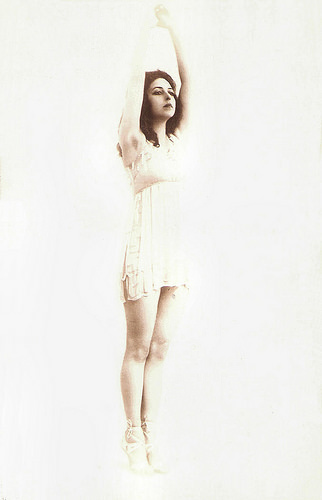
French postcard by Editions Gordon & Cie., Vincennes (Seine).
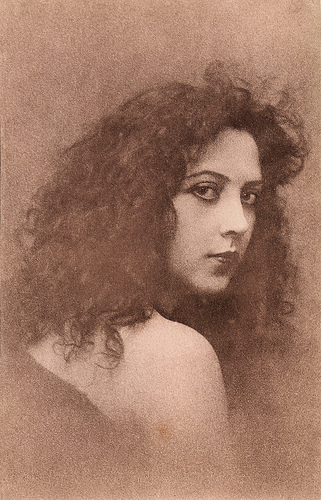
French postcard by Editions Sid, Paris, no. 8039. Photo: G.I. Manuel Frères.
Gift of the Muses
Musidora was born Jeanne Roques in Paris, France in 1889. She was raised by a feminist mother and socialist father.
She began her career in the arts at an early age, writing her first novel at the age of fifteen and acting on the stage with the likes of Colette, one of her lifelong friends. She performed in revues at French music halls and cabarets, such as the Folies Bergère, Concert Mayol, and La Cigale. Jeanne adopted the stage name Musidora (Greek for "gift of the muses"), after the heroine in Théophile Gautier's novel Fortunio.
She made her film debut already around 1909, but in 1914, she started to appear regularly in short silent films like Les miseres de l'aiguille/The misery of the needle (Raphael Clamour, 1914). She starred in a few silent films by Gaston Ravel, including La bouquetière des Catalans/The Flower Girl of Catalonia (Gaston Ravel, 1914) and Le trophée du Zouave/The Zouave trophy (Gaston Ravel, 1915).
She also began to work with the highly successful film director Louis Feuillade, and appeared in a dozen of his short silent films for Gaumont, including Severo Torelli (Louis Feuillade, 1914), Tu n'épouseras jamais un avocet/You will never marry a lawyer (Louis Feuillade, 1914) featuring Marcel Lévesque , Le calvaire/The Calvary (Louis Feuillade, 1914) with René Navarre , and Les noces d'argent/Silver Wedding (Louis Feuillade, 1915) with Édouard Mathé .
Musidora then appeared in his hugely successful serial Les Vampires/The Vampires (Louis Feuillade, 1915-1916) as cabaret singer Irma Vep (an anagram of ‘vampire’) opposite Édouard Mathé as crusading journalist Philippe Guerande. Les Vampires was not actually about vampires, but about a criminal gang-cum-secret society inspired by the exploits of the real-life Bonnot Gang.
Musidora’s mystique was accentuated in Les Vampires by her large, dark eyes and wearing a black leotard, hood and tights. Besides playing a leading role in the Vampires' crimes, Irma Vep also spends two episodes under the hypnotic control of Moreno, a rival criminal who makes her his lover and induces her to assassinate the Grand Vampire. The series used gadgets like poison rings, poison fountain pens, cabinets with fake back panels etc. It was an immediate success with French cinema-goers and ran in 10 installments until 1916.
After the Les Vampires serial, Musidora starred as Diana Monti in Judex (Louis Feuillade, 1917), another popular Feuillade serial filmed in 1916 but delayed for release until 1917 because of World War I. Judex is a twelve part serial following the adventures of the masked vigilante Judex ( René Cresté ) as he fights against criminals led by the corrupt banker Favrauxom. Les Vampires and Judex have been lauded by critics like André Bazin as the birth of avant-garde cinema and cited by filmmakers as Fritz Lang and Luis Buñuel as being extremely influential in their desires to become directors.
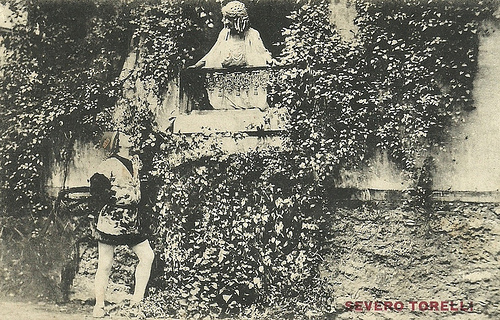
French postcard by Maury's International Attraction Circuit. Photo: publicity still for Severo Torelli (Louis Feuillade, 1914). Severo Torelli was a French silent feature, produced by Gaumont and based on a 1883 play by François Coppée. Fernand Herrmann played the title role and the female lead was for Renée Carl (Dona Pia). Musidora played Portia.
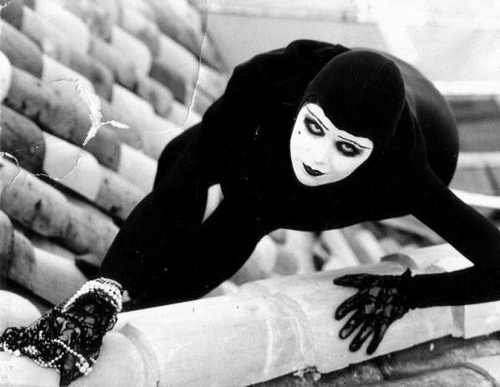
Musidora as Irma Vep in Les Vampires (Louis Feuillade, 1915-1916). Collection: The Island of Cinema @ Flickr.
The most deserving girl of France
Musidora also starred in films by other directors, like in Le pied qui étreint (Jacques Feyder, 1916) - a funny send-up of the Feuillade's serials, the silent adventure film Les chacals/The Jackals (André Hugon, 1917), starring André Nox, La jeune fille la plus méritante de France/The most deserving girl of France (Germaine Dulac, 1918), and Mademoiselle Chiffon (André Hugon, 1919), with Suzanne Munte.
Apart from her acting career, she became a film producer and director under the tutelage of her mentor, Louis Feuillade. Her first film was an adaptation of a novel by her friend Colette, La vagabonda/The Vagabond (Musidora, Eugenio Perego, 1918). Between the late 1910s and early 1920s, she directed ten films, all of which are lost with the exception of two: the tragic romance Soleil et ombre/Sol y sombre/Sun and Shadow (Jaime De Lasuen, Musidora, 1922) and La terre des taureaux/La tierra de los toros/The Land of the Bulls (Musidora, 1924), both of which were filmed in Spain, starring the Cordoban mounted bullfighter Antonio Cañero.
In Italy, she produced and directed La Flamme Cachée/The Hidden Flame (Roger Lion, Musidora, 1918) based on another work by Colette. At a time when many women in the film industry were relegated to acting, Musidora achieved a degree of success as a producer and director.
Annette Förster writes in an article at Women Film Pioneers Project: “While her films were favorably reviewed in the press, Musidora as producer reputedly only lost money on them. It remains unclear whether this was due to the terms of her contract, as she claimed in a 1946 interview with Renee Sylvaire , or to the fact that the films failed at the box office.”
Her final film role was as Delilah in the drama Le berceau de dieu/The Cradle of God (Fred LeRoy Granville, 1926) After her career as an actress was over, she focused on writing and producing. Her last film was an homage to her mentor Feuillade entitled La Magique Image/The Magic Image (1950), which she both directed and starred in.
Late in her life she would occasionally work in the ticket booth of the Cinematheque Francaise. Few patrons realised that the older woman in the foyer might be starring in the film they were watching.
At 68, Musidora died in Paris, France in 1957 and was laid to rest in the Cimetière de Bois-le-Roi. Musidora was married to Dr. Clément Marot from 1927 till 1944. The union produced one child, Clément Marot Jr.
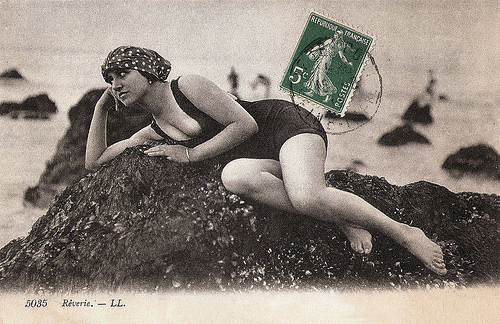
French postcard, no. 5035. Caption: Rêverie. -LL. Several online sources identified this bathing beauty as Musidora, but we're not sure. Rêverie translates as Daydream, LL possibly refers to Les Landes, the department in southwestern France with its beautiful beaches.
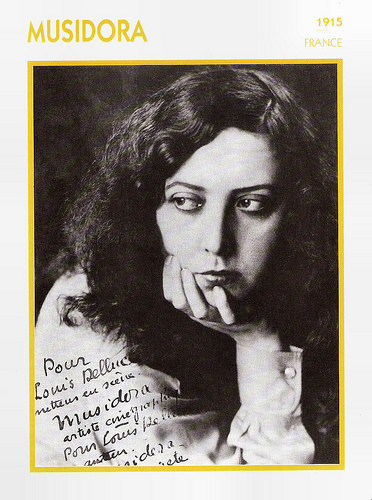
French collectors card in the series 'Portrait de Stars; L'encyclopédie du Cinéma' by Edito Service, 1992. Photo: Collection Cinémathèque Française. Caption: Musidora, 1915, France.
Sources: Annette Förster (Women Film Pioneers Project), Bobb Edwards (Find A Grave), Wikipedia, and .
With her heavily kohled dark eyes, somewhat sinister make-up, pale skin and exotic wardrobes, French actress Musidora (1889-1957) created an unforgettable vamp persona. She is best known for her roles in the Louis Feuillade serials Les Vampires (1915-1916) as Irma Vep, the voluptuous, amoral villainess, and in Judex (1917) as Marie Verdier. At a time when many women in the film industry were relegated to acting, Musidora also achieved some success as a producer and director. Later she became a journalist and wrote about cinema.

French postcard by Editions Gordon & Cie., Vincennes (Seine).

French postcard by Editions Sid, Paris, no. 8039. Photo: G.I. Manuel Frères.
Gift of the Muses
Musidora was born Jeanne Roques in Paris, France in 1889. She was raised by a feminist mother and socialist father.
She began her career in the arts at an early age, writing her first novel at the age of fifteen and acting on the stage with the likes of Colette, one of her lifelong friends. She performed in revues at French music halls and cabarets, such as the Folies Bergère, Concert Mayol, and La Cigale. Jeanne adopted the stage name Musidora (Greek for "gift of the muses"), after the heroine in Théophile Gautier's novel Fortunio.
She made her film debut already around 1909, but in 1914, she started to appear regularly in short silent films like Les miseres de l'aiguille/The misery of the needle (Raphael Clamour, 1914). She starred in a few silent films by Gaston Ravel, including La bouquetière des Catalans/The Flower Girl of Catalonia (Gaston Ravel, 1914) and Le trophée du Zouave/The Zouave trophy (Gaston Ravel, 1915).
She also began to work with the highly successful film director Louis Feuillade, and appeared in a dozen of his short silent films for Gaumont, including Severo Torelli (Louis Feuillade, 1914), Tu n'épouseras jamais un avocet/You will never marry a lawyer (Louis Feuillade, 1914) featuring Marcel Lévesque , Le calvaire/The Calvary (Louis Feuillade, 1914) with René Navarre , and Les noces d'argent/Silver Wedding (Louis Feuillade, 1915) with Édouard Mathé .
Musidora then appeared in his hugely successful serial Les Vampires/The Vampires (Louis Feuillade, 1915-1916) as cabaret singer Irma Vep (an anagram of ‘vampire’) opposite Édouard Mathé as crusading journalist Philippe Guerande. Les Vampires was not actually about vampires, but about a criminal gang-cum-secret society inspired by the exploits of the real-life Bonnot Gang.
Musidora’s mystique was accentuated in Les Vampires by her large, dark eyes and wearing a black leotard, hood and tights. Besides playing a leading role in the Vampires' crimes, Irma Vep also spends two episodes under the hypnotic control of Moreno, a rival criminal who makes her his lover and induces her to assassinate the Grand Vampire. The series used gadgets like poison rings, poison fountain pens, cabinets with fake back panels etc. It was an immediate success with French cinema-goers and ran in 10 installments until 1916.
After the Les Vampires serial, Musidora starred as Diana Monti in Judex (Louis Feuillade, 1917), another popular Feuillade serial filmed in 1916 but delayed for release until 1917 because of World War I. Judex is a twelve part serial following the adventures of the masked vigilante Judex ( René Cresté ) as he fights against criminals led by the corrupt banker Favrauxom. Les Vampires and Judex have been lauded by critics like André Bazin as the birth of avant-garde cinema and cited by filmmakers as Fritz Lang and Luis Buñuel as being extremely influential in their desires to become directors.

French postcard by Maury's International Attraction Circuit. Photo: publicity still for Severo Torelli (Louis Feuillade, 1914). Severo Torelli was a French silent feature, produced by Gaumont and based on a 1883 play by François Coppée. Fernand Herrmann played the title role and the female lead was for Renée Carl (Dona Pia). Musidora played Portia.

Musidora as Irma Vep in Les Vampires (Louis Feuillade, 1915-1916). Collection: The Island of Cinema @ Flickr.
The most deserving girl of France
Musidora also starred in films by other directors, like in Le pied qui étreint (Jacques Feyder, 1916) - a funny send-up of the Feuillade's serials, the silent adventure film Les chacals/The Jackals (André Hugon, 1917), starring André Nox, La jeune fille la plus méritante de France/The most deserving girl of France (Germaine Dulac, 1918), and Mademoiselle Chiffon (André Hugon, 1919), with Suzanne Munte.
Apart from her acting career, she became a film producer and director under the tutelage of her mentor, Louis Feuillade. Her first film was an adaptation of a novel by her friend Colette, La vagabonda/The Vagabond (Musidora, Eugenio Perego, 1918). Between the late 1910s and early 1920s, she directed ten films, all of which are lost with the exception of two: the tragic romance Soleil et ombre/Sol y sombre/Sun and Shadow (Jaime De Lasuen, Musidora, 1922) and La terre des taureaux/La tierra de los toros/The Land of the Bulls (Musidora, 1924), both of which were filmed in Spain, starring the Cordoban mounted bullfighter Antonio Cañero.
In Italy, she produced and directed La Flamme Cachée/The Hidden Flame (Roger Lion, Musidora, 1918) based on another work by Colette. At a time when many women in the film industry were relegated to acting, Musidora achieved a degree of success as a producer and director.
Annette Förster writes in an article at Women Film Pioneers Project: “While her films were favorably reviewed in the press, Musidora as producer reputedly only lost money on them. It remains unclear whether this was due to the terms of her contract, as she claimed in a 1946 interview with Renee Sylvaire , or to the fact that the films failed at the box office.”
Her final film role was as Delilah in the drama Le berceau de dieu/The Cradle of God (Fred LeRoy Granville, 1926) After her career as an actress was over, she focused on writing and producing. Her last film was an homage to her mentor Feuillade entitled La Magique Image/The Magic Image (1950), which she both directed and starred in.
Late in her life she would occasionally work in the ticket booth of the Cinematheque Francaise. Few patrons realised that the older woman in the foyer might be starring in the film they were watching.
At 68, Musidora died in Paris, France in 1957 and was laid to rest in the Cimetière de Bois-le-Roi. Musidora was married to Dr. Clément Marot from 1927 till 1944. The union produced one child, Clément Marot Jr.

French postcard, no. 5035. Caption: Rêverie. -LL. Several online sources identified this bathing beauty as Musidora, but we're not sure. Rêverie translates as Daydream, LL possibly refers to Les Landes, the department in southwestern France with its beautiful beaches.

French collectors card in the series 'Portrait de Stars; L'encyclopédie du Cinéma' by Edito Service, 1992. Photo: Collection Cinémathèque Française. Caption: Musidora, 1915, France.
Sources: Annette Förster (Women Film Pioneers Project), Bobb Edwards (Find A Grave), Wikipedia, and .
Published on March 30, 2017 22:00
March 29, 2017
Christine Kaufmann (1945-2017)
On 28 March 2017, German actress Christine Kaufmann passed away. Only seven, she made her film debut in an adaptation of Im weißen Rößl/The White Horse Inn (1952). As an adult, Kaufmann moved to Hollywood and married Tony Curtis. Later she appeared in films by Werner Schroeter and Rainer Werner Fassbinder and became 'Germany's most beautiful grandmother'. Christine Kaufmann was 72.
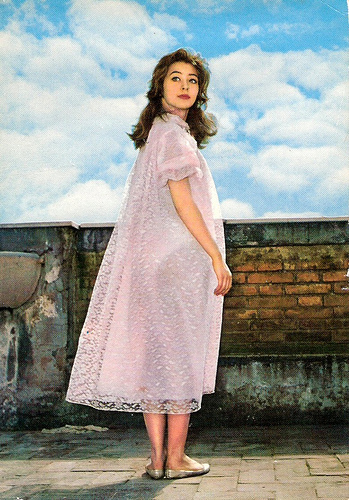
German postcard by Krüger, no. 902/60.
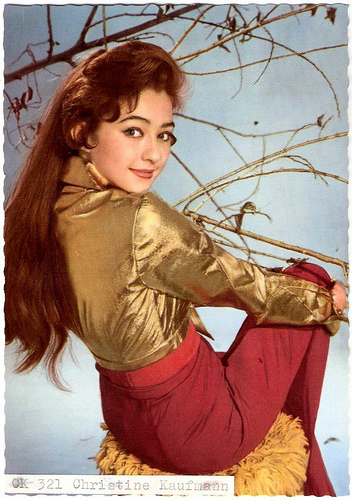
German postcard by Ufa, Berlin-Tempelhof, no. CK-321. Photo: Klaus Collignon / Ufa.
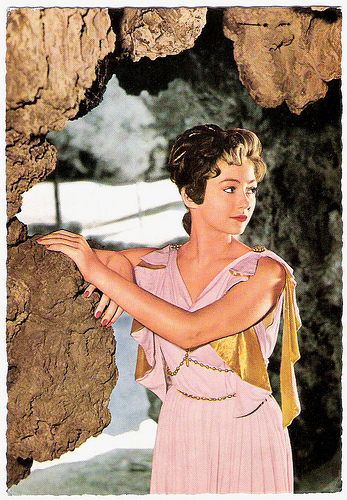
German postcard by WS-Druck, Wanne-Eickel, no. F 157.
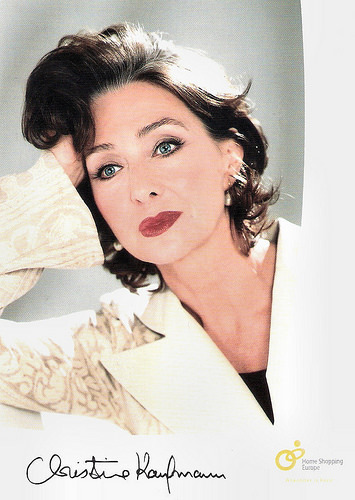
German autograph card by Home Shopping Europe.
Lolita
Christine Maria Kaufmann was born in Lengdorf, Styria in what is now Austria, in 1945. Her father was a German Luftwaffe officer and her mother a French doctor who gave up her practice to help further Christine's career.
She grew up in München (Munich) and trained as a ballerina at the Staatstheater am Gärtnerplatz and later at the Staatsopernballett (Munich Opera). She started her film career at the age of seven with a small role in the musical Im weißen Rößl/White Horse Inn ( Willi Forst , 1952).
The film which brought her fame was Rosen-Resli/Rose-Girl Resli (Harald Reinl, 1954), when she was only nine. The film was a gigantic success in post-war Germany and she moved millions of Germans to tears.
Soon she appeared in such films as Der schweigende Engel/The Silent Angel (Harald Reinl, 1954), Wenn die Alpenrosen blüh'n/When the Alpine Roses Bloom (Hans Deppe, Richard Häussler, 1955) with Hertha Feiler , and Ein Herz schlägt für Erika/A Heart Beats for Erika (Harald Reinl, 1956) with Grethe Weiser.
She gained international recognition when she played alongside Carla Gravina in Primo Amore/First Love (Mario Camerini, 1958), and with Steve Reeves in the Peplum Gli ultimi giorni di Pompei/The Last Days of Pompeii (Mario Bonnard, Sergio Leone, 1959).
Kaufmann c-starred with Kirk Douglas in Town Without Pity (Gottfried Reinhardt, 1961). She won the Golden Globe that year as the Most Promising Newcomer for her role. The press of the period was less concerned with Kaufmann's histrionic skills than with the revealing bikini which she wore in her early scenes.
That year she also appeared opposite Gert Fröbe in the interesting thriller Via Mala (Paul May, 1961), and with Jean-Paul Belmondo in Un nommé La Rocca/A Man Names Rocca (Jean Becker, 1961).
The following year she appeared in the uneven escape film Escape from East Berlin (Robert Siodmak, 1962) opposite Don Murray, but she turned down the title role of Lolita (Stanley Kubrick, 1962) which went to Sue Lyon.
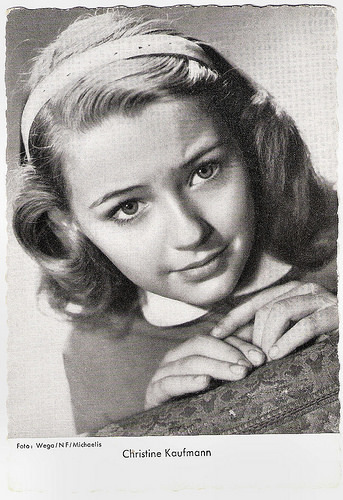
German postcard by WS-Druck, Wanne-Eickel. Photo: Wego / NF/ Michaelis. Publicity still for Ein Herz schlägt für Erika/A Heart beats for Erika (Harald Reinl, 1956).
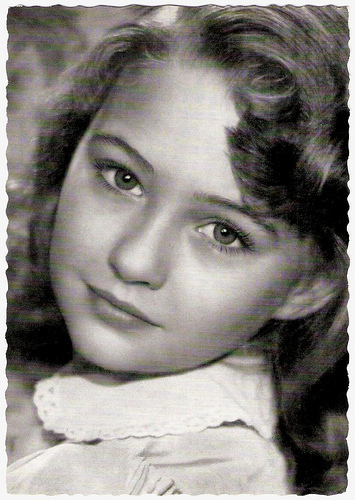
German postcard by Filmbilder-Vertrieb Ernst Freihoff, Essen. Retail price: 10 Pfg. Photo: Lantin / Panorama Film.
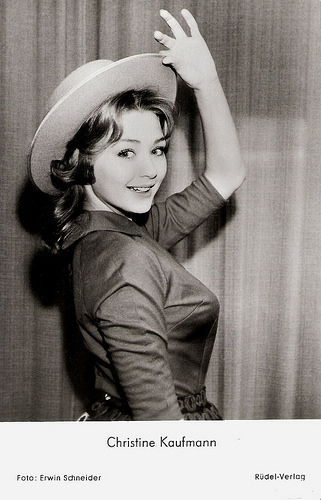
German postcard by Rüdel-Verlag, Hamburg-Bergedorf, no. 2986. Photo: Erwin Schneider.
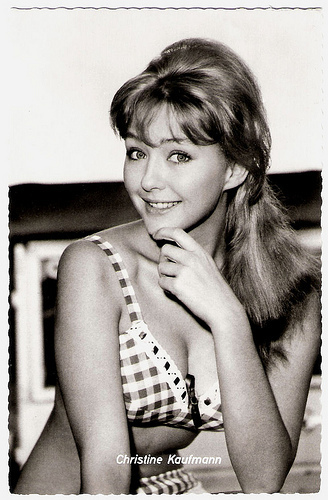
German postcard by Kolibri-Verlag, Minden/Westf., no. 1436.
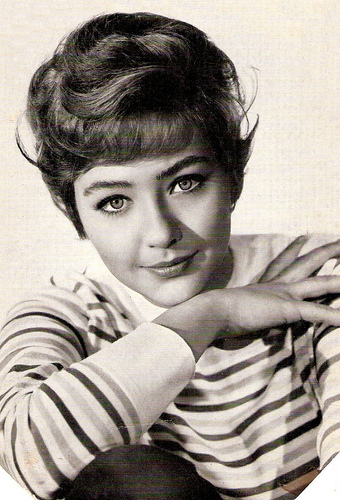
German postcard, no. 10. Photo: Melodie.
Beauty
Christine Kaufmann was 17 when she met Tony Curtis on the set of the big budget epic Taras Bulba (J. Lee Thompson, 1962) in Argentina. Curtis divorced his wife Janet Leigh and married Kaufmann in 1963. They appeared together in the frothy Universal comedy Wild and Wonderful (Michael Anderson, 1964). She briefly retired from films to give birth to two daughters, Alexandra (1964) and Allegra (1966). The pair divorced in 1968.
Kaufmann resumed her career in Germany, which she had interrupted during her marriage. The TV mini-series Wie ein Blitz/Like A Flash (Rolf von Sydow, 1960) became a huge success. On TV she also appeared in Krimis like Der Kommissar (1972) and Derrick (1977).
For the cinema she often worked with director Werner Schroeter and his star Magdalena Montezuma in such films as Der Tod der Maria Malibran/The Death of Maria Malibran (1971), Willow Springs (1973), Goldflocken/Gold Flakes (1976) and Tag der Idioten/Day of the Idiots (1981) with Carole Bouquet. She also acted in several films by Rainer Werner Fassbinder like the TV film Welt am Draht/World on Wire (1973), Lili Marleen (1981) and Lola (1981).
Other international films were the Giallo Enigma rosso/Virgin Killer (Alberto Negrin, 1978) with Fabio Testi, the cult favourite Bagdad Café/Out of Rosenheim (Percy Adlon, 1987), and the comedy Haider lebt - 1. April 2021/Haider Lives - a April 2021 (Peter Kern, 2002).
In 1995, after posing nude for Playboy Magazine at the age of 54, she was nicknamed 'Germany's most beautiful grandmother'. In later years, Christine Kaufmann regularly appeared in TV series and also had her own line of cosmetics. She wrote several books about beauty and health, as well as two autobiographies.
Christine Kaufmann died on 28 March 2017 in Munich, Germany from leukaemia. She was 72. After her marriage to Tony Curtis, Kaufmann was married to Kaufmann married the television director Achim Lenz (1974-76), musician and actor Reno Eckstein (1979-1982) and illustrator Klaus Zey (1997-2011).
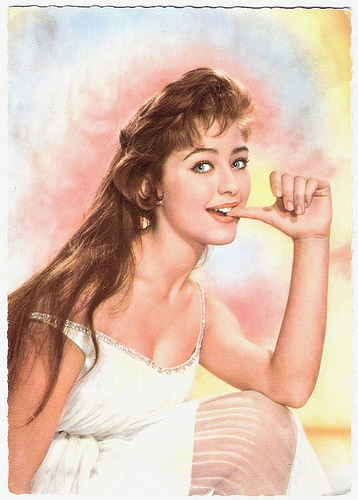
German postcard by Universum-Film Aktiengesellschaft (Ufa), Berlin-Tempelhof, no. CK 302. Photo: Klaus Collignon / Ufa.
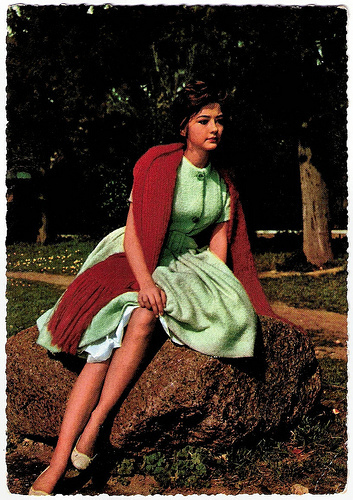
German postcard by Krüger, no. 902/61.
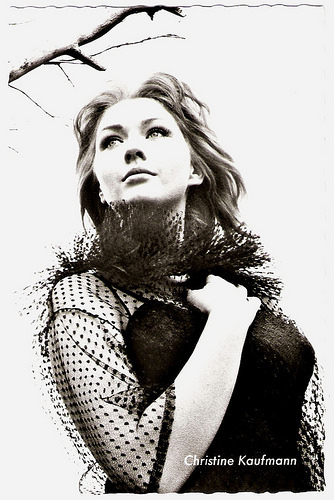
German postcard by Starpostkarten-Vertrieb Ernst Freihoff, Essen, no. 1013. Photo: Lothar Winkler.
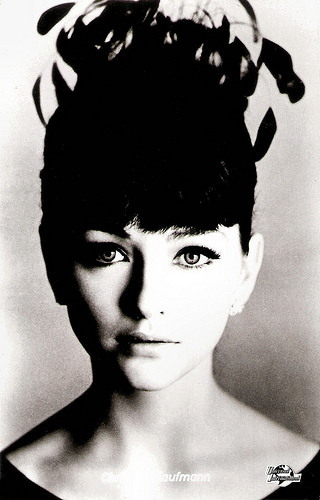
German postcard by Kolibri Fotokarte, Minden/Westf., no. 2396. Photo: Universal. Publicity still for Monsieur Cognac/Wild and Wonderful (Michael Anderson, 1964).
Scene of Taras Bulba (1962). Source: GSMovieMoments (YouTube).
Sources: Hal Erickson (AllMovie), and Wikipedia.

German postcard by Krüger, no. 902/60.

German postcard by Ufa, Berlin-Tempelhof, no. CK-321. Photo: Klaus Collignon / Ufa.

German postcard by WS-Druck, Wanne-Eickel, no. F 157.

German autograph card by Home Shopping Europe.
Lolita
Christine Maria Kaufmann was born in Lengdorf, Styria in what is now Austria, in 1945. Her father was a German Luftwaffe officer and her mother a French doctor who gave up her practice to help further Christine's career.
She grew up in München (Munich) and trained as a ballerina at the Staatstheater am Gärtnerplatz and later at the Staatsopernballett (Munich Opera). She started her film career at the age of seven with a small role in the musical Im weißen Rößl/White Horse Inn ( Willi Forst , 1952).
The film which brought her fame was Rosen-Resli/Rose-Girl Resli (Harald Reinl, 1954), when she was only nine. The film was a gigantic success in post-war Germany and she moved millions of Germans to tears.
Soon she appeared in such films as Der schweigende Engel/The Silent Angel (Harald Reinl, 1954), Wenn die Alpenrosen blüh'n/When the Alpine Roses Bloom (Hans Deppe, Richard Häussler, 1955) with Hertha Feiler , and Ein Herz schlägt für Erika/A Heart Beats for Erika (Harald Reinl, 1956) with Grethe Weiser.
She gained international recognition when she played alongside Carla Gravina in Primo Amore/First Love (Mario Camerini, 1958), and with Steve Reeves in the Peplum Gli ultimi giorni di Pompei/The Last Days of Pompeii (Mario Bonnard, Sergio Leone, 1959).
Kaufmann c-starred with Kirk Douglas in Town Without Pity (Gottfried Reinhardt, 1961). She won the Golden Globe that year as the Most Promising Newcomer for her role. The press of the period was less concerned with Kaufmann's histrionic skills than with the revealing bikini which she wore in her early scenes.
That year she also appeared opposite Gert Fröbe in the interesting thriller Via Mala (Paul May, 1961), and with Jean-Paul Belmondo in Un nommé La Rocca/A Man Names Rocca (Jean Becker, 1961).
The following year she appeared in the uneven escape film Escape from East Berlin (Robert Siodmak, 1962) opposite Don Murray, but she turned down the title role of Lolita (Stanley Kubrick, 1962) which went to Sue Lyon.

German postcard by WS-Druck, Wanne-Eickel. Photo: Wego / NF/ Michaelis. Publicity still for Ein Herz schlägt für Erika/A Heart beats for Erika (Harald Reinl, 1956).

German postcard by Filmbilder-Vertrieb Ernst Freihoff, Essen. Retail price: 10 Pfg. Photo: Lantin / Panorama Film.

German postcard by Rüdel-Verlag, Hamburg-Bergedorf, no. 2986. Photo: Erwin Schneider.

German postcard by Kolibri-Verlag, Minden/Westf., no. 1436.

German postcard, no. 10. Photo: Melodie.
Beauty
Christine Kaufmann was 17 when she met Tony Curtis on the set of the big budget epic Taras Bulba (J. Lee Thompson, 1962) in Argentina. Curtis divorced his wife Janet Leigh and married Kaufmann in 1963. They appeared together in the frothy Universal comedy Wild and Wonderful (Michael Anderson, 1964). She briefly retired from films to give birth to two daughters, Alexandra (1964) and Allegra (1966). The pair divorced in 1968.
Kaufmann resumed her career in Germany, which she had interrupted during her marriage. The TV mini-series Wie ein Blitz/Like A Flash (Rolf von Sydow, 1960) became a huge success. On TV she also appeared in Krimis like Der Kommissar (1972) and Derrick (1977).
For the cinema she often worked with director Werner Schroeter and his star Magdalena Montezuma in such films as Der Tod der Maria Malibran/The Death of Maria Malibran (1971), Willow Springs (1973), Goldflocken/Gold Flakes (1976) and Tag der Idioten/Day of the Idiots (1981) with Carole Bouquet. She also acted in several films by Rainer Werner Fassbinder like the TV film Welt am Draht/World on Wire (1973), Lili Marleen (1981) and Lola (1981).
Other international films were the Giallo Enigma rosso/Virgin Killer (Alberto Negrin, 1978) with Fabio Testi, the cult favourite Bagdad Café/Out of Rosenheim (Percy Adlon, 1987), and the comedy Haider lebt - 1. April 2021/Haider Lives - a April 2021 (Peter Kern, 2002).
In 1995, after posing nude for Playboy Magazine at the age of 54, she was nicknamed 'Germany's most beautiful grandmother'. In later years, Christine Kaufmann regularly appeared in TV series and also had her own line of cosmetics. She wrote several books about beauty and health, as well as two autobiographies.
Christine Kaufmann died on 28 March 2017 in Munich, Germany from leukaemia. She was 72. After her marriage to Tony Curtis, Kaufmann was married to Kaufmann married the television director Achim Lenz (1974-76), musician and actor Reno Eckstein (1979-1982) and illustrator Klaus Zey (1997-2011).

German postcard by Universum-Film Aktiengesellschaft (Ufa), Berlin-Tempelhof, no. CK 302. Photo: Klaus Collignon / Ufa.

German postcard by Krüger, no. 902/61.

German postcard by Starpostkarten-Vertrieb Ernst Freihoff, Essen, no. 1013. Photo: Lothar Winkler.

German postcard by Kolibri Fotokarte, Minden/Westf., no. 2396. Photo: Universal. Publicity still for Monsieur Cognac/Wild and Wonderful (Michael Anderson, 1964).
Scene of Taras Bulba (1962). Source: GSMovieMoments (YouTube).
Sources: Hal Erickson (AllMovie), and Wikipedia.
Published on March 29, 2017 22:00
March 28, 2017
Ada Reeve
British stage and film actress Ada Reeve (1874-1966) was much loved on three continents. She was one of the most popular British singing comediennes of her time, and considered to be a headliner in variety and vaudeville. She was endowed with a softness of voice and delicacy of performance that quite set her apart from virtually all of her more raucous contemporaries in the music halls and popularised many memorable songs.
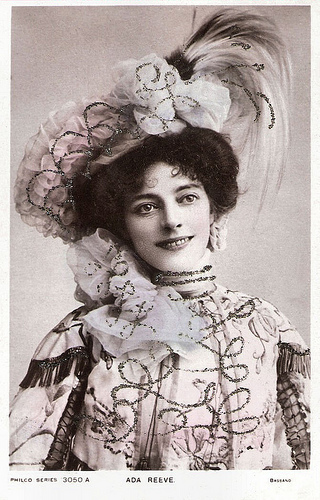
British postcard by the Philco Publishing Co., London, no. 3050 A. Photo: Bassano.
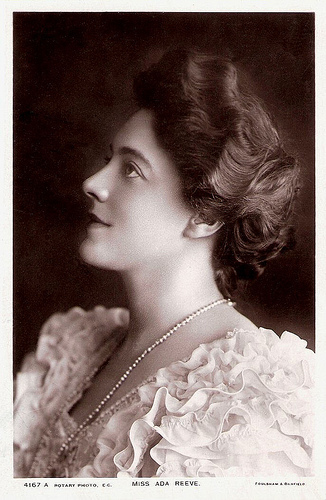
British postcard by Rotary Photo, no. 4167. Photo: Foulsham & Banfield.
The Family Meal Ticket
Ada Reeve was born as Adelaide Mary Isaacs in London, England, in 1874. She was the first of many children of minor actor Charles Reeves and dancer Harriet Saunders.
‘Little Ada Reeves’ made her first stage appearance at just four years old in the pantomime Red Riding Hood at the Pavilion Theatre in London in 1878. A series of pantomime and dramatic roles followed. Her talent, even at so early an age was obvious and Ada soon became the family meal ticket.
As a teenager, it became apparent that musical comedy was Ada's particular talent and she began working as a music hall performer under the name Ada Reeve. She soon became firmly established as one of the principal light comedy artistes and sang many songs which attained great popularity.
Her She Was a Clergyman’s Daughter was a seemingly innocent, but actually risqué music hall song about a clergyman's daughter who was not as naive or charitable as she would have you imagine.
Reeve performed the song in a demure costume of a flounced dress and bonnet, letting the audience in on the racy innuendos of the song through knowing winks and gestures.
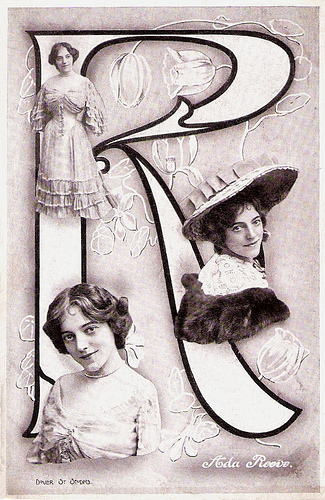
British postcard in the Smart Novels Series by Dover Street Studios.
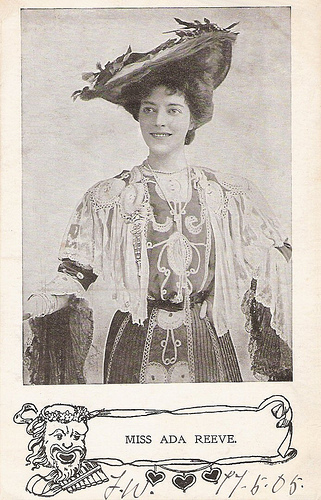
British postcard. Sent by mail in 1905.
Gaiety Girl
In 1894, Ada Reeve married actor Bert Gilbert and returned to mainstream theatre, first touring as Haidee in Don Juan.
Later that year she became one of George Edwardes famous Gaiety girls and made her West End Debut as Bessie Brent in The Shop Girl. She neglected to tell Edwardes that she was pregnant when offered the part, and had to leave midway through the run of 546 performances as her condition became more delicate.
She returned in All Abroad at the Criterion Theatre (1895), and as the title character in the hit The Girl from Paris (1896) at the Duke of York's Theatre.
She and her husband then toured Australia. However, the marriage with Gilbert had turned sour, with Reeve claiming extreme cruelty and petitioning for divorce while still in Australia. On the return sea journey to England, Reeve was forced to appeal to the captain of the ship for protection from him.
Once in England, the couple separated, and the divorce was finalised in 1900. Ada Reeve settled in London with her two daughters, Bessie Adelaide Hazlewood (1895) and Lillian Mary "Goody" Hazlewood (1897).
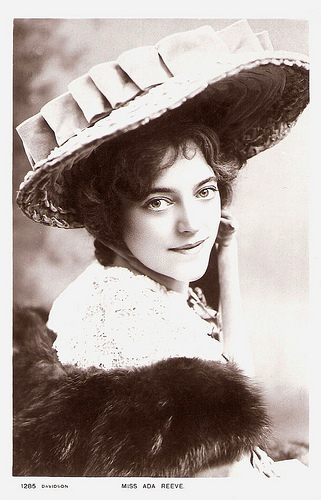
British postcard by Davidson Bros. in the Glossyphoto Series, no. 1285.
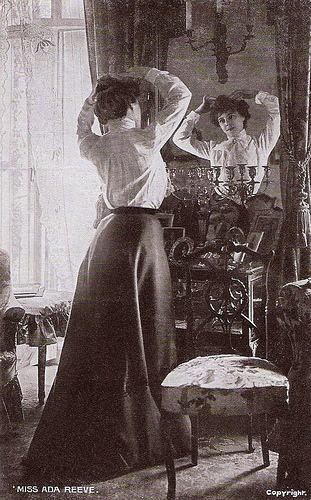
British postcard in The Star Series by G.D.&D., London.
Variety and Vaudeville
In 1898, Reeve played the role of Madame Celeste in Milord, Sir Smith, followed by the role of Cleopatra in The Great Caesar in 1899.
Later that year, she created the role of Lady Holyrood in the hit musical comedy Florodora at the Lyric Theatre. In 1900-1901, she again toured Australia, in Florodora.
Reeve joined the cast of the hit musical San Toy in 1901, and later took over the title role from Marie Tempest.
Reeve remarried in 1902 to manager and actor Wilfred Cotton. Under his management, she played Miss Ventnor in The Medal and the Maid (1903) and the title role in Winnie Brooke, Widow (1904). In 1906 and 1909, she toured South Africa with her husband, becoming very popular.
Over the following years, Reeve played in variety shows in England and enjoyed extensive foreign tours, including South Africa and the US in 1911, South Africa in 1913, Australia in 1914, Australia and South Africa in 1918, South Africa in 1920, Australia from 1922 to 1924, and in 1926 and 1929, the last time playing in vaudeville.
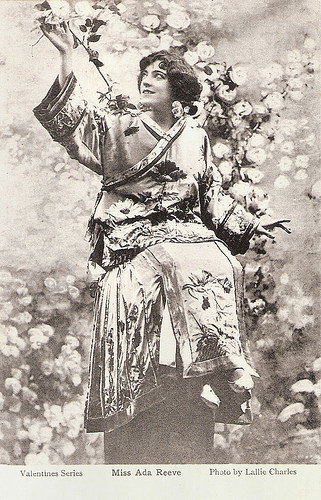
British postcard in the Valentine Series. Photo: Lallie Charles (née Charlotte Elizabeth Martin). Possibly this was a publicity still for the stage musical San Toy. Reeve joined the cast of this hit musical in 1901, playing Dudley and later taking over the title role from Marie Tempest.
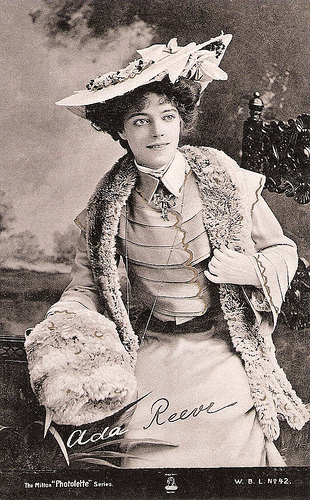
British postcard in the Milton Photolette Series, no. 42 by Woolstone Bros., London. Sent by mail in 1908.
Take It For A Fact
Ada Reeve was absent from England from 1929 to 1935. Both of her daughters, Bessie and Goody, had in the meantime settled in Australia, where both married and had children. Goody became a well known radio personality, while Bessie died of an illness in 1954.
Upon Ada's return to England, she appeared in cabarets, revues and variety. Her next dramatic role was in 1940 in the musical Black Velvet.
During the 1940s and 1950s she would appear between stage performances in nine films. The first was the fantasy They Came to a City (Basil Dearden, 1945) starring Googie Withers. In this film she repeated her stage performance as charwoman Mrs. Batley in J.B. Priestley's play They Came To A City.
However, her first film appearance had been some 25 years earlier, in the silent film Comradeship (Maurice Elvey, 1919), a war drama starring Lily Elsie.
Her other film roles included supporting parts in the romantic comedy Dear Mr. Prohack (Thornton Freeland, 1949) with Cecil Parker, the Film Noir Night and the City (Jules Dassin, 1950) starring Richard Widmark, and I Believe in You (Basil Dearden, Michael Relph, 1952) with Celia Johnson .
At the age of 80, she retired from the stage but made two more films, the last of which was at the age of 83, in the comedy A Passionate Stranger (Muriel Box, 1957) with Ralph Richardson . She also appeared on TV in episodes of Lilli Palmer Theatre (1956) and Nicholas Nickleby (1957).
Ada Reeve died in London, in 1966, at the age of 92. She could look back on a career that had spanned almost eighty years from her first childhood performance on stage to her last veteran appearance on film. Her autobiography was published as Take It For A Fact.
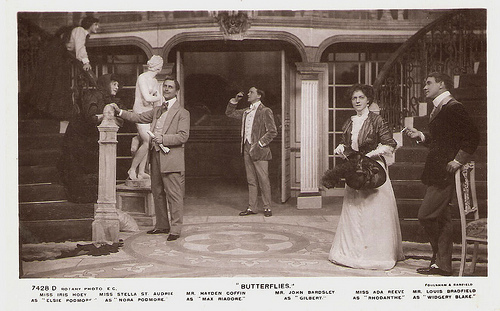
British postcard by Rotary Photo, no. 7428 D. Photo: Foulsham & Banfield. Publicity still for the stage play Butterflies with Iris Hoey, Stella St. Audrie, C. Hayden Coffin, John Bardsley, Ada Reeve and Louis Bradfield. Butterflies is a musical play in three acts by William J. Locke, lyrics by T.H. Read and music by J.A. Robertson. Produced at the Apollo Theatre, London in 1908.
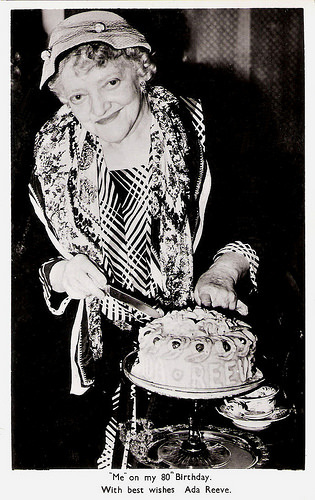
British postcard, 1954. Caption: Me on my 80th Birthday. With best wishes, Ada Reeve.
Sources: Don Gillan (Stage Beauty), Martina Lipton (It’s Behind You), Wikipedia and .

British postcard by the Philco Publishing Co., London, no. 3050 A. Photo: Bassano.

British postcard by Rotary Photo, no. 4167. Photo: Foulsham & Banfield.
The Family Meal Ticket
Ada Reeve was born as Adelaide Mary Isaacs in London, England, in 1874. She was the first of many children of minor actor Charles Reeves and dancer Harriet Saunders.
‘Little Ada Reeves’ made her first stage appearance at just four years old in the pantomime Red Riding Hood at the Pavilion Theatre in London in 1878. A series of pantomime and dramatic roles followed. Her talent, even at so early an age was obvious and Ada soon became the family meal ticket.
As a teenager, it became apparent that musical comedy was Ada's particular talent and she began working as a music hall performer under the name Ada Reeve. She soon became firmly established as one of the principal light comedy artistes and sang many songs which attained great popularity.
Her She Was a Clergyman’s Daughter was a seemingly innocent, but actually risqué music hall song about a clergyman's daughter who was not as naive or charitable as she would have you imagine.
Reeve performed the song in a demure costume of a flounced dress and bonnet, letting the audience in on the racy innuendos of the song through knowing winks and gestures.

British postcard in the Smart Novels Series by Dover Street Studios.

British postcard. Sent by mail in 1905.
Gaiety Girl
In 1894, Ada Reeve married actor Bert Gilbert and returned to mainstream theatre, first touring as Haidee in Don Juan.
Later that year she became one of George Edwardes famous Gaiety girls and made her West End Debut as Bessie Brent in The Shop Girl. She neglected to tell Edwardes that she was pregnant when offered the part, and had to leave midway through the run of 546 performances as her condition became more delicate.
She returned in All Abroad at the Criterion Theatre (1895), and as the title character in the hit The Girl from Paris (1896) at the Duke of York's Theatre.
She and her husband then toured Australia. However, the marriage with Gilbert had turned sour, with Reeve claiming extreme cruelty and petitioning for divorce while still in Australia. On the return sea journey to England, Reeve was forced to appeal to the captain of the ship for protection from him.
Once in England, the couple separated, and the divorce was finalised in 1900. Ada Reeve settled in London with her two daughters, Bessie Adelaide Hazlewood (1895) and Lillian Mary "Goody" Hazlewood (1897).

British postcard by Davidson Bros. in the Glossyphoto Series, no. 1285.

British postcard in The Star Series by G.D.&D., London.
Variety and Vaudeville
In 1898, Reeve played the role of Madame Celeste in Milord, Sir Smith, followed by the role of Cleopatra in The Great Caesar in 1899.
Later that year, she created the role of Lady Holyrood in the hit musical comedy Florodora at the Lyric Theatre. In 1900-1901, she again toured Australia, in Florodora.
Reeve joined the cast of the hit musical San Toy in 1901, and later took over the title role from Marie Tempest.
Reeve remarried in 1902 to manager and actor Wilfred Cotton. Under his management, she played Miss Ventnor in The Medal and the Maid (1903) and the title role in Winnie Brooke, Widow (1904). In 1906 and 1909, she toured South Africa with her husband, becoming very popular.
Over the following years, Reeve played in variety shows in England and enjoyed extensive foreign tours, including South Africa and the US in 1911, South Africa in 1913, Australia in 1914, Australia and South Africa in 1918, South Africa in 1920, Australia from 1922 to 1924, and in 1926 and 1929, the last time playing in vaudeville.

British postcard in the Valentine Series. Photo: Lallie Charles (née Charlotte Elizabeth Martin). Possibly this was a publicity still for the stage musical San Toy. Reeve joined the cast of this hit musical in 1901, playing Dudley and later taking over the title role from Marie Tempest.

British postcard in the Milton Photolette Series, no. 42 by Woolstone Bros., London. Sent by mail in 1908.
Take It For A Fact
Ada Reeve was absent from England from 1929 to 1935. Both of her daughters, Bessie and Goody, had in the meantime settled in Australia, where both married and had children. Goody became a well known radio personality, while Bessie died of an illness in 1954.
Upon Ada's return to England, she appeared in cabarets, revues and variety. Her next dramatic role was in 1940 in the musical Black Velvet.
During the 1940s and 1950s she would appear between stage performances in nine films. The first was the fantasy They Came to a City (Basil Dearden, 1945) starring Googie Withers. In this film she repeated her stage performance as charwoman Mrs. Batley in J.B. Priestley's play They Came To A City.
However, her first film appearance had been some 25 years earlier, in the silent film Comradeship (Maurice Elvey, 1919), a war drama starring Lily Elsie.
Her other film roles included supporting parts in the romantic comedy Dear Mr. Prohack (Thornton Freeland, 1949) with Cecil Parker, the Film Noir Night and the City (Jules Dassin, 1950) starring Richard Widmark, and I Believe in You (Basil Dearden, Michael Relph, 1952) with Celia Johnson .
At the age of 80, she retired from the stage but made two more films, the last of which was at the age of 83, in the comedy A Passionate Stranger (Muriel Box, 1957) with Ralph Richardson . She also appeared on TV in episodes of Lilli Palmer Theatre (1956) and Nicholas Nickleby (1957).
Ada Reeve died in London, in 1966, at the age of 92. She could look back on a career that had spanned almost eighty years from her first childhood performance on stage to her last veteran appearance on film. Her autobiography was published as Take It For A Fact.

British postcard by Rotary Photo, no. 7428 D. Photo: Foulsham & Banfield. Publicity still for the stage play Butterflies with Iris Hoey, Stella St. Audrie, C. Hayden Coffin, John Bardsley, Ada Reeve and Louis Bradfield. Butterflies is a musical play in three acts by William J. Locke, lyrics by T.H. Read and music by J.A. Robertson. Produced at the Apollo Theatre, London in 1908.

British postcard, 1954. Caption: Me on my 80th Birthday. With best wishes, Ada Reeve.
Sources: Don Gillan (Stage Beauty), Martina Lipton (It’s Behind You), Wikipedia and .
Published on March 28, 2017 22:00
March 27, 2017
Mathias Wieman
German actor Mathias Wieman (1902-1969) starred in more than 50 films was and made Staatsschauspieler, the highest honour attainable by an actor in Germany. But a few years later he was classified as ‘persona non grata’ by Joseph Goebbels, which reduced his stage and film performances at the height of his career. After the war he became a popular supporting actor in films.
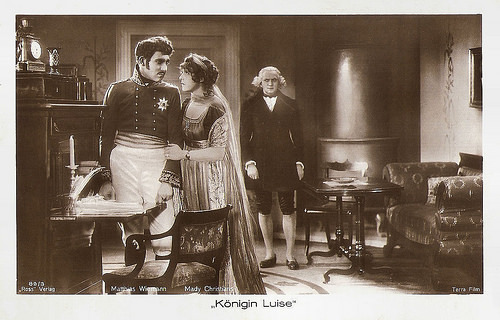
German postcard by Ross Verlag, no. 89/3, 1925-1935. Photo: Terra Film. Publicity still for Königin Luise/Queen Louise (Karl Grune, 1927) with Mady Christians .
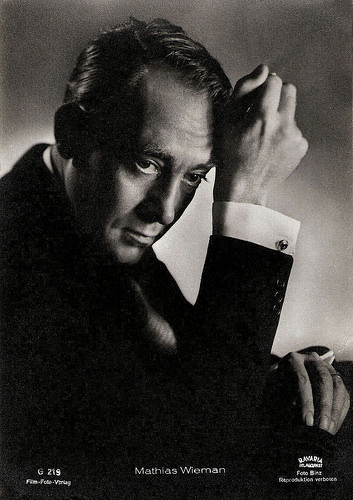
German postcard by Film-Foto-Verlag, no. G 219. Photo: Binz / Bavaria Filmkunst.
Leni Riefenstahl
Mathias Wieman was born Carl Heinrich Franz Mathias Wieman in Osnabrück in 1902. He was the only son of Carl Philipp Anton Wieman and his wife Louise.
Raised in Osnabrück, Wiesbaden and Berlin, where he studied four terms of philosophy, history of art and languages, Wieman wanted to become an airplane designer and flier.
He started his acting career at the Deutsches Theater in Berlin under the direction of Max Reinhardt. His debut role was Moritz Stiefel in Frank Wedekind’s Frühlings Erwachen (Spring Awakening).
In the early 1920s, he was a member of the Holtorf-Truppe, a stock theatre group that included future director Veit Harlan . His fellow stage actors included his future wife, Erika Meingast, Marlene Dietrich , and Max Schreck (the vampire in Nosferatu).
Later he began working in silent films, including Mata Hari, die rote Tänzerin/Mata Hari: the Red Dancer (Friedrich Feher, 1927), Feme (Richard Oswald, 1927), Königin Luise/Queen Louise (Karl Grune, 1927) opposite Mady Christians , and Das Land ohne Frauen/Bride Number 68 (Carmine Gallone, 1929) starring Conrad Veidt.
In 1930, along with Leni Riefenstahl , he appeared in the mountain film Stürme über dem Mont Blanc/Avalanche (Arnold Fanck, 1930), and in 1932 he played the male lead in Riefenstahl's Das Blaue Licht/The Blue Light (Béla Balázs, Leni Riefenstahl, 1932).

German postcard by Ross Verlag, no. A 1894/1, 1937-1938. Photo: Ufa / Hämmerer.

German postcard by Film-Foto-Verlag, no. A 3723/2, 1941-1944. Photo: Binz / Bavaria Filmkunst.

German postcard by Film-Foto-Verlag, no. A 3948/1, 1941-1944. Photo: Binz / Bavaria Filmkunst.
Actor of the State and Persona non grata
During the 1930s, at the height of his film career, Mathias Wieman acted in such productions as Mensch ohne Namen/The Man Without a Name (Gustav Ucicky, 1932), Die Herrin von Atlantis/L’ Atlantide/Queen of Atlantis (Georg Wilhelm Pabst, 1932) with Brigitte Helm , Die Gräfin von Monte Christo/The Countess of Monte Cristo (Karl Hartl, 1932), and Fräulein Hoffmanns Erzählungen/Tales of Miss Hoffmann (Carl Lamac, 1933) with Anny Ondra ,
After the rise of the Nazis he acted in Der Schimmelreiter/The Rider of the White Horse (Hans Deppe, Curt Oertel, 1934), Viktoria (Carl Hoffmann, 1935) with Luise Ullrich , Patrioten/Patriots (Karl Ritter, 1937), and Togger (Jürgen von Alten, 1937) with Paul Hartmann .
He had an international success with his appearance in Die ewige Maske/The Eternal Mask (Werner Hochbaum, 1935). The film was in 1937 nominated for an award at the Venice Film Festival, and awarded with the American National Board of Review Award for Best Foreign Film.
Also in 1937, Wieman was made Staatsschauspieler, an honorary title bestowed by the German government and the highest honour attainable by an actor in Germany. In 1936 Wieman had produced the Frankenburger Würfelspiel of the Nazi playwright Eberhard Wolfgang Möller in association with the 1936 Summer Olympics and the inauguration of the Dietrich-Eckart-Bühne, and also played the Black Knight.
However, Wieman was eventually classed as ‘persona non grata’ by Joseph Goebbels, the Minister of Propaganda who was responsible for film production in Germany.This reduced Wieman’s activity. He took part in a few films like Ich klage an/I Accuse (Wolfgang Liebeneiner, 1941), Das andere Ich/The other I (Wolfgang Liebeneiner, 1941), Paracelsus (Georg Wilhelm Pabst, 1943) starring Werner Krauss , Träumerei/Dreaming (Harald Braun, 1944) opposite Hilde Krahl , and Wie sagen wir es unseren Kindern/How Do We Tell Our Children (Hans Deppe, 1945).
After the failed 20 July 1944 plot to assassinate Adolf Hitler, Mathias and his wife Erika helped the family of Count Fritz-Dietlof von der Schulenburg. This assistance, at great risk to themselves, is detailed by Charlotte von der Schulenburg in the book Courageous Hearts: Women and the Anti-Hitler Plot of 1944.
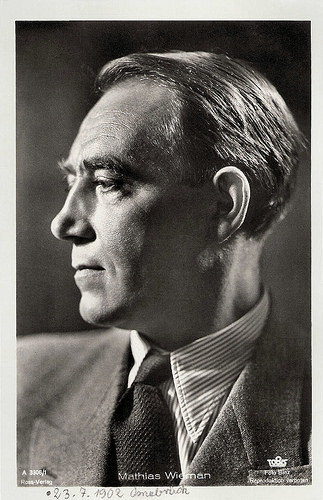
German postcard by Ross Verlag, no. A 3306/1, 1941-1944. Photo: Binz / Tobis.

German postcard by Film-Foto-Verlag, no. A 3435/1, 1941-1944. Photo: Tobis / Binz.
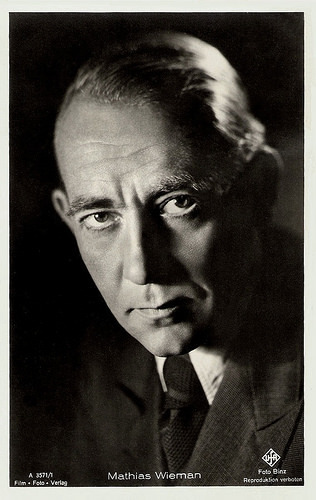
German postcard by Film-Foto-Verlag, no. A 3571/1, 1941-1944. Photo: Ufa / Binz.
Alfred Nobel
After World War II, Mathias Wieman was able to work more intensively in the film business again, normally in supporting roles. To his fairly well-known work belongs Herz der Welt/The Alfred Nobel Story (Harald Braun, 1952) in which Wieman portrayed Dr. Alfred Nobel, Solange du da bist/As Long as You're Near Me (Harald Braun, 1953), Der letzte Sommer/The Last Summer (Harald Braun, 1954), and Reifende Jugend/Ripening Youth (Ulrich Erfurth, 1955).
He appeared opposite Romy Schneider and Horst Buchholz in Robinson soll nicht sterben/The Girl and the Legend (Josef von Báky, 1957), and opposite Ingrid Bergman in Rossellini's La Paura/Fear (Roberto Rossellini, 1954).
Two of these films were in competition at the Cannes Film Festival: Herz Der Welt in 1952, and Solange Du Da Bist in 1954.
He also made many records of classic stories where he would narrate the story accompanied by orchestral music. On stage, Wieman appeared in countless productions, including Goethe's Faust, Pygmalion by George Bernard Shaw, Six Characters in Search of an Author by Luigi Pirandello, and Im Dickicht der Städte (In The Jungle of Cities) by Bertolt Brecht.
After the war Mathias Wieman and his wife Erika Meingast moved to Switzerland. In 1969 he died of cancer in Zurich, soon followed by his wife. The couple had no children.
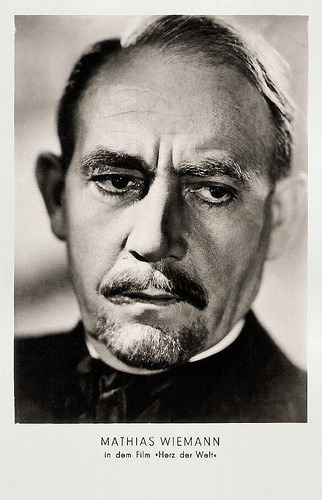
East-German postcard by VEB Volkskunstverlag Reichenbach i.V., no. G 704, 1956. Photo: NDF / Schorchtfilm. Publicity still for Herz der Welt/The Alfred Nobel Story (Harald Braun, 1952).
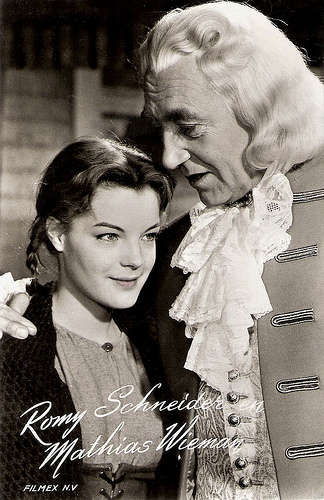
Dutch postcard by Takken, Utrecht, no. AX 3078. Photo: Filmex NV. Publicity still for Robinson soll nicht sterben/The Girl and the Legend (Josef von Báky, 1957) with Romy Schneider and Mathias Wieman.
Sources: Dieter Svensson (Mathias Wieman Site), Wikipedia, and .

German postcard by Ross Verlag, no. 89/3, 1925-1935. Photo: Terra Film. Publicity still for Königin Luise/Queen Louise (Karl Grune, 1927) with Mady Christians .

German postcard by Film-Foto-Verlag, no. G 219. Photo: Binz / Bavaria Filmkunst.
Leni Riefenstahl
Mathias Wieman was born Carl Heinrich Franz Mathias Wieman in Osnabrück in 1902. He was the only son of Carl Philipp Anton Wieman and his wife Louise.
Raised in Osnabrück, Wiesbaden and Berlin, where he studied four terms of philosophy, history of art and languages, Wieman wanted to become an airplane designer and flier.
He started his acting career at the Deutsches Theater in Berlin under the direction of Max Reinhardt. His debut role was Moritz Stiefel in Frank Wedekind’s Frühlings Erwachen (Spring Awakening).
In the early 1920s, he was a member of the Holtorf-Truppe, a stock theatre group that included future director Veit Harlan . His fellow stage actors included his future wife, Erika Meingast, Marlene Dietrich , and Max Schreck (the vampire in Nosferatu).
Later he began working in silent films, including Mata Hari, die rote Tänzerin/Mata Hari: the Red Dancer (Friedrich Feher, 1927), Feme (Richard Oswald, 1927), Königin Luise/Queen Louise (Karl Grune, 1927) opposite Mady Christians , and Das Land ohne Frauen/Bride Number 68 (Carmine Gallone, 1929) starring Conrad Veidt.
In 1930, along with Leni Riefenstahl , he appeared in the mountain film Stürme über dem Mont Blanc/Avalanche (Arnold Fanck, 1930), and in 1932 he played the male lead in Riefenstahl's Das Blaue Licht/The Blue Light (Béla Balázs, Leni Riefenstahl, 1932).

German postcard by Ross Verlag, no. A 1894/1, 1937-1938. Photo: Ufa / Hämmerer.

German postcard by Film-Foto-Verlag, no. A 3723/2, 1941-1944. Photo: Binz / Bavaria Filmkunst.

German postcard by Film-Foto-Verlag, no. A 3948/1, 1941-1944. Photo: Binz / Bavaria Filmkunst.
Actor of the State and Persona non grata
During the 1930s, at the height of his film career, Mathias Wieman acted in such productions as Mensch ohne Namen/The Man Without a Name (Gustav Ucicky, 1932), Die Herrin von Atlantis/L’ Atlantide/Queen of Atlantis (Georg Wilhelm Pabst, 1932) with Brigitte Helm , Die Gräfin von Monte Christo/The Countess of Monte Cristo (Karl Hartl, 1932), and Fräulein Hoffmanns Erzählungen/Tales of Miss Hoffmann (Carl Lamac, 1933) with Anny Ondra ,
After the rise of the Nazis he acted in Der Schimmelreiter/The Rider of the White Horse (Hans Deppe, Curt Oertel, 1934), Viktoria (Carl Hoffmann, 1935) with Luise Ullrich , Patrioten/Patriots (Karl Ritter, 1937), and Togger (Jürgen von Alten, 1937) with Paul Hartmann .
He had an international success with his appearance in Die ewige Maske/The Eternal Mask (Werner Hochbaum, 1935). The film was in 1937 nominated for an award at the Venice Film Festival, and awarded with the American National Board of Review Award for Best Foreign Film.
Also in 1937, Wieman was made Staatsschauspieler, an honorary title bestowed by the German government and the highest honour attainable by an actor in Germany. In 1936 Wieman had produced the Frankenburger Würfelspiel of the Nazi playwright Eberhard Wolfgang Möller in association with the 1936 Summer Olympics and the inauguration of the Dietrich-Eckart-Bühne, and also played the Black Knight.
However, Wieman was eventually classed as ‘persona non grata’ by Joseph Goebbels, the Minister of Propaganda who was responsible for film production in Germany.This reduced Wieman’s activity. He took part in a few films like Ich klage an/I Accuse (Wolfgang Liebeneiner, 1941), Das andere Ich/The other I (Wolfgang Liebeneiner, 1941), Paracelsus (Georg Wilhelm Pabst, 1943) starring Werner Krauss , Träumerei/Dreaming (Harald Braun, 1944) opposite Hilde Krahl , and Wie sagen wir es unseren Kindern/How Do We Tell Our Children (Hans Deppe, 1945).
After the failed 20 July 1944 plot to assassinate Adolf Hitler, Mathias and his wife Erika helped the family of Count Fritz-Dietlof von der Schulenburg. This assistance, at great risk to themselves, is detailed by Charlotte von der Schulenburg in the book Courageous Hearts: Women and the Anti-Hitler Plot of 1944.

German postcard by Ross Verlag, no. A 3306/1, 1941-1944. Photo: Binz / Tobis.

German postcard by Film-Foto-Verlag, no. A 3435/1, 1941-1944. Photo: Tobis / Binz.

German postcard by Film-Foto-Verlag, no. A 3571/1, 1941-1944. Photo: Ufa / Binz.
Alfred Nobel
After World War II, Mathias Wieman was able to work more intensively in the film business again, normally in supporting roles. To his fairly well-known work belongs Herz der Welt/The Alfred Nobel Story (Harald Braun, 1952) in which Wieman portrayed Dr. Alfred Nobel, Solange du da bist/As Long as You're Near Me (Harald Braun, 1953), Der letzte Sommer/The Last Summer (Harald Braun, 1954), and Reifende Jugend/Ripening Youth (Ulrich Erfurth, 1955).
He appeared opposite Romy Schneider and Horst Buchholz in Robinson soll nicht sterben/The Girl and the Legend (Josef von Báky, 1957), and opposite Ingrid Bergman in Rossellini's La Paura/Fear (Roberto Rossellini, 1954).
Two of these films were in competition at the Cannes Film Festival: Herz Der Welt in 1952, and Solange Du Da Bist in 1954.
He also made many records of classic stories where he would narrate the story accompanied by orchestral music. On stage, Wieman appeared in countless productions, including Goethe's Faust, Pygmalion by George Bernard Shaw, Six Characters in Search of an Author by Luigi Pirandello, and Im Dickicht der Städte (In The Jungle of Cities) by Bertolt Brecht.
After the war Mathias Wieman and his wife Erika Meingast moved to Switzerland. In 1969 he died of cancer in Zurich, soon followed by his wife. The couple had no children.

East-German postcard by VEB Volkskunstverlag Reichenbach i.V., no. G 704, 1956. Photo: NDF / Schorchtfilm. Publicity still for Herz der Welt/The Alfred Nobel Story (Harald Braun, 1952).

Dutch postcard by Takken, Utrecht, no. AX 3078. Photo: Filmex NV. Publicity still for Robinson soll nicht sterben/The Girl and the Legend (Josef von Báky, 1957) with Romy Schneider and Mathias Wieman.
Sources: Dieter Svensson (Mathias Wieman Site), Wikipedia, and .
Published on March 27, 2017 22:00
March 26, 2017
Imported from the USA: Olive Moorefield
During the 1950s and 1960s, American singer and actress Olive Moorefield (1932) worked in Austria and West Germany. She starred on stage in musicals and operas, acted in several films, including Monpti (1957) with Romy Schneider and Horst Buchholz, and Onkel Toms Hütte/Uncle Tom’s Cabin (1964), and she appeared in television shows.
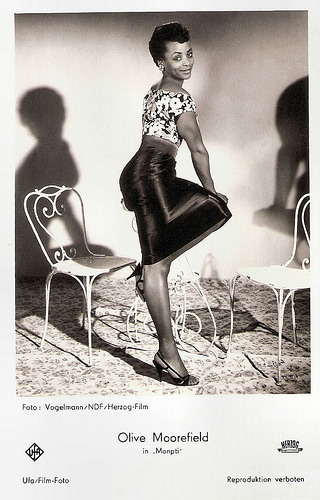
German postcard by Ufa. Photo: Vogelmann / NDF / Herzog-film. Publicity still for Monpti (Helmut Käutner, 1957).
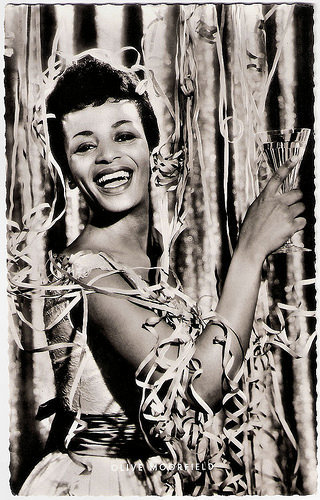
German postcard by Kunst und Bild, Berlin-Charlottenburg, no. V 172. Photo: Kurt-Ulrich-Film / Constantin / Wesel. Publicity still for Die Beine von Dolores/The legs of Dolores (Géza von Cziffra, 1957).
Very unusual
Olive Moorefield was born in 1932, in Pittsburgh, Pennsylvania, USA. She had seven siblings. After attending the Pennsylvania College, she took singing and acting lessons. In October 1952 she debuted on Broadway in New York in the play My Darlin 'Aida.
Moorefield went on extensive European tour and settled down in 1953 in Vienna, Austria. There she received a commitment at the Vienna Volksoper. At the time, this was very unusual in Europe for a black artist. She celebrated her first success with the Cole Porter musical Kiss Me Kate. Initially, she played the supporting role of Bianca, but later also the leading role of the Kate. Many other productions would follow in the next two decades and Moorefield became very popular among Viennese audiences.
Soon also parts in films followed. Moorefield first appeared as a singer in such Austrian films as the drama Das Licht der Liebe/The Light of Love (Robert A. Stemmle, 1954) with Paula Wessely , the comedy Liebe, die den Kopf verliert/Love that loses its head (Thomas Engel, 1956) starring Paul Hubschmid and the musical Scherben bringen Glück/Seven Years Hard Luck (Ernst Marischka, 1957) with Adrian Hoven .
She made several records and did not shy away from pop music. In Germany, she also appeared again as a singer in light entertainment as Einmal eine grosse Dame sein/To be a great lady for once (Erik Ode, 1957) and Die Beine von Dolores/The legs of Dolores (Géza von Cziffra, 1957).
Her first bigger part was in the melancholic romantic comedy-drama Monpti/Love from Paris (Helmut Käutner, 1957), starring Romy Schneider and Horst Bucholz , then Germany's biggest stars, as the young lovers. She also had a supporting part in Der schwarze Blitz/The black flash (Hans Grimm, 1958), featuring ski champion Toni Sailer .
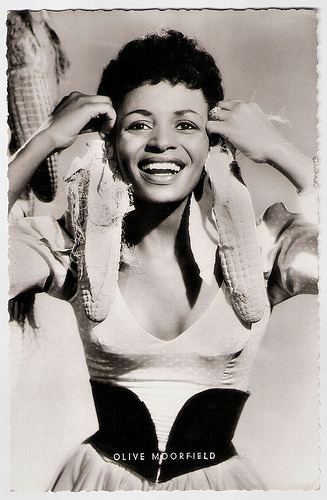
German postcard by Kunst und Bild, Berlin-Charlottenburg, no. T 875. Photo: Kurt-Ulrich-Film / Constantin / Wesel. Publicity still for Die Beine von Dolores/The legs of Dolores (Géza von Cziffra, 1957).
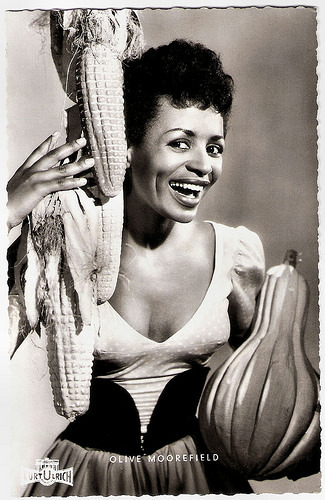
German postcard by Kunst und Bild, Berlin-Charlottenburg, no. V 181. Photo: Kurt-Ulrich-Film / Wesel. Publicity still for Die Beine von Dolores/The legs of Dolores (Géza von Cziffra, 1957).
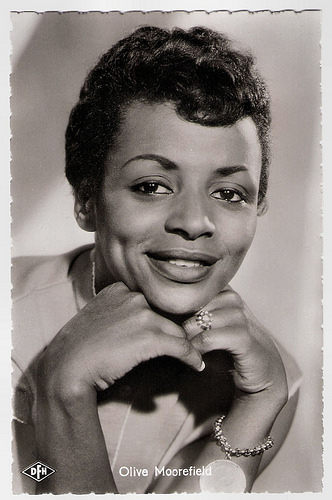
German postcard by Kolibri-Verlag G.m.b.H., Minden/Westf., no. 2644. Photo: CCC / Deutsche Film Hansa (DFH) / Arthur Grimm. Publicity still for Einmal eine grosse Dame sein/To be a great lady for once (Erik Ode, 1957).
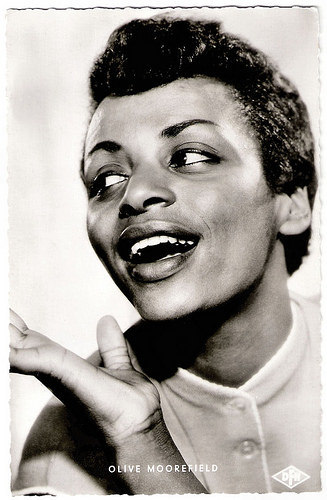
German postcard by Kunst und Bild, Berlin-Charlottenburg, no. I 254. Photo: Grimm / CCC / Deutsche Film Hansa. Publicity still for Einmal eine grosse Dame sein/Once a great lady (Erik Ode, 1957).
Before Mandingo and Drum there was Uncle Tom's Cabin
Olive Moorefield had her first leading role in the cinema in the Austrian comedy Skandal um Dodo/Scandal around Dodo (Eduard von Borsody, 1959) opposite Harald Juhnke. After that she returned to guest parts as a singer in Riviera-Story/Riviera Story (Wolfgang Becker, 1961) with Ulla Jacobsson , and Straße der Verheißung/Street of Temptation (Imo Moszkowicz, 1962) starring Mario Adorf .
She had another another leading role in Onkel Toms Hütte/Uncle Tom's Cabin (Géza von Radványi, 1965). The film is based on Harriet Beecher Stowe's classic novel of the same name. In the pre-Civil War South, a sadistic plantation-owner ( Herbert Lom ) brutalises his slaves to the point of them having no other choice but to rebel. Always obedient, peaceful and honest old slave Tom (John Kitzmiller) plays a central role in this tragedy. Moorefield played the slave Cassy.
Jugu Abraham at IMDb: "While the film is true to Harriet Beecher Stowe's story, the director's implicit comparison of the past and present America (skyscraper skyline shown during the credits) is interesting. Eartha Kitt's song at the end is unforgettable. The film is distinctly European (the director is Hungarian) in style and the story and songs could merit a re-release." Actually, there was a curious American re-release in 1976,Uncle Tom's Cabin (Al Adamson, 1976), edited from the 1965 film but with new scenes added. It was promoted with the tagline 'Before Mandingo and Drum there was Uncle Tom's Cabin'.
In the following decade, Moorefield did not return to the cinema, but she kept appearing in the German-speaking theatre and on TV. She was Bess in the Vienna production of George Gershwin's Porgy and Bess, which was also televised. I
n 1969 Olive Moorefield married Dr. Kurt Mach, with whom she has a son, Oliver Mach. She gradually withdrew from the limelight into private life. In later years, her name (now Olive Moorefield-Mach) reappeared on the administrative side at music festivals.
Olive Moorefield sings Bongo Rock in Das alte Försterhaus (1956). Source: fritz51203 (YouTube).
Olive Moorefield sings Etwas leise Musik in Der schwarze Blitz/The black flash (1958) with Oliver Grimm. Source: fritz51203 (YouTube).
Sources: Wikipedia (German) and .

German postcard by Ufa. Photo: Vogelmann / NDF / Herzog-film. Publicity still for Monpti (Helmut Käutner, 1957).

German postcard by Kunst und Bild, Berlin-Charlottenburg, no. V 172. Photo: Kurt-Ulrich-Film / Constantin / Wesel. Publicity still for Die Beine von Dolores/The legs of Dolores (Géza von Cziffra, 1957).
Very unusual
Olive Moorefield was born in 1932, in Pittsburgh, Pennsylvania, USA. She had seven siblings. After attending the Pennsylvania College, she took singing and acting lessons. In October 1952 she debuted on Broadway in New York in the play My Darlin 'Aida.
Moorefield went on extensive European tour and settled down in 1953 in Vienna, Austria. There she received a commitment at the Vienna Volksoper. At the time, this was very unusual in Europe for a black artist. She celebrated her first success with the Cole Porter musical Kiss Me Kate. Initially, she played the supporting role of Bianca, but later also the leading role of the Kate. Many other productions would follow in the next two decades and Moorefield became very popular among Viennese audiences.
Soon also parts in films followed. Moorefield first appeared as a singer in such Austrian films as the drama Das Licht der Liebe/The Light of Love (Robert A. Stemmle, 1954) with Paula Wessely , the comedy Liebe, die den Kopf verliert/Love that loses its head (Thomas Engel, 1956) starring Paul Hubschmid and the musical Scherben bringen Glück/Seven Years Hard Luck (Ernst Marischka, 1957) with Adrian Hoven .
She made several records and did not shy away from pop music. In Germany, she also appeared again as a singer in light entertainment as Einmal eine grosse Dame sein/To be a great lady for once (Erik Ode, 1957) and Die Beine von Dolores/The legs of Dolores (Géza von Cziffra, 1957).
Her first bigger part was in the melancholic romantic comedy-drama Monpti/Love from Paris (Helmut Käutner, 1957), starring Romy Schneider and Horst Bucholz , then Germany's biggest stars, as the young lovers. She also had a supporting part in Der schwarze Blitz/The black flash (Hans Grimm, 1958), featuring ski champion Toni Sailer .

German postcard by Kunst und Bild, Berlin-Charlottenburg, no. T 875. Photo: Kurt-Ulrich-Film / Constantin / Wesel. Publicity still for Die Beine von Dolores/The legs of Dolores (Géza von Cziffra, 1957).

German postcard by Kunst und Bild, Berlin-Charlottenburg, no. V 181. Photo: Kurt-Ulrich-Film / Wesel. Publicity still for Die Beine von Dolores/The legs of Dolores (Géza von Cziffra, 1957).

German postcard by Kolibri-Verlag G.m.b.H., Minden/Westf., no. 2644. Photo: CCC / Deutsche Film Hansa (DFH) / Arthur Grimm. Publicity still for Einmal eine grosse Dame sein/To be a great lady for once (Erik Ode, 1957).

German postcard by Kunst und Bild, Berlin-Charlottenburg, no. I 254. Photo: Grimm / CCC / Deutsche Film Hansa. Publicity still for Einmal eine grosse Dame sein/Once a great lady (Erik Ode, 1957).
Before Mandingo and Drum there was Uncle Tom's Cabin
Olive Moorefield had her first leading role in the cinema in the Austrian comedy Skandal um Dodo/Scandal around Dodo (Eduard von Borsody, 1959) opposite Harald Juhnke. After that she returned to guest parts as a singer in Riviera-Story/Riviera Story (Wolfgang Becker, 1961) with Ulla Jacobsson , and Straße der Verheißung/Street of Temptation (Imo Moszkowicz, 1962) starring Mario Adorf .
She had another another leading role in Onkel Toms Hütte/Uncle Tom's Cabin (Géza von Radványi, 1965). The film is based on Harriet Beecher Stowe's classic novel of the same name. In the pre-Civil War South, a sadistic plantation-owner ( Herbert Lom ) brutalises his slaves to the point of them having no other choice but to rebel. Always obedient, peaceful and honest old slave Tom (John Kitzmiller) plays a central role in this tragedy. Moorefield played the slave Cassy.
Jugu Abraham at IMDb: "While the film is true to Harriet Beecher Stowe's story, the director's implicit comparison of the past and present America (skyscraper skyline shown during the credits) is interesting. Eartha Kitt's song at the end is unforgettable. The film is distinctly European (the director is Hungarian) in style and the story and songs could merit a re-release." Actually, there was a curious American re-release in 1976,Uncle Tom's Cabin (Al Adamson, 1976), edited from the 1965 film but with new scenes added. It was promoted with the tagline 'Before Mandingo and Drum there was Uncle Tom's Cabin'.
In the following decade, Moorefield did not return to the cinema, but she kept appearing in the German-speaking theatre and on TV. She was Bess in the Vienna production of George Gershwin's Porgy and Bess, which was also televised. I
n 1969 Olive Moorefield married Dr. Kurt Mach, with whom she has a son, Oliver Mach. She gradually withdrew from the limelight into private life. In later years, her name (now Olive Moorefield-Mach) reappeared on the administrative side at music festivals.
Olive Moorefield sings Bongo Rock in Das alte Försterhaus (1956). Source: fritz51203 (YouTube).
Olive Moorefield sings Etwas leise Musik in Der schwarze Blitz/The black flash (1958) with Oliver Grimm. Source: fritz51203 (YouTube).
Sources: Wikipedia (German) and .
Published on March 26, 2017 22:00
March 25, 2017
Tomas Milian (1933-2017)
On Wednesday 22 March 2017, Cuban-American actor Tomas Milian passed away. He worked extensively in Italian films from the early 1960s to the late 1980s. Milian played neurotic and sadistic killers in several Spaghetti Westerns of the 1960s and lone-wolf anti-heroes in violent action and police thrillers of the 1970s. Very popular in Italy were his crime-comedies of the late 1970s and 1980s. Besides these genre films, he worked with such prolific directors as Mauro Bolognini, Luchino Visconti, Bernardo Bertolucci and Michelangelo Antonioni. Tomas Milian was 84.
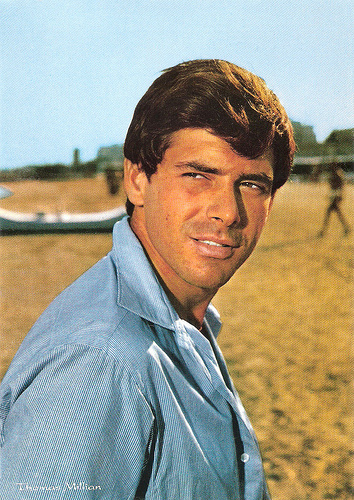
Italian postcard by Rotalfoto, Milano, in the series Artisti di sempre, no. 118.
Eyewitness
Tomas Milian was born as Tomás Quintín Rodríguez in Havana, Cuba in 1933 (some sources say 1932). His name is also written as Tomás Milián and Thomas Milian.
He is the son of Tomas Rodriguez, a general serving the dictatorship of Gerardo. His father was arrested and jailed after dictator Fulgencio Batista took power in Cuba in 1933. Rodriguez committed suicide in 1945 in his home, with Tomás as an eyewitness.
In 1955, Milian decided to leave Cuba. Arriving in Miami he worked in several small jobs. He joined the navy for a few months to get his American citizenship.
In New York he auditioned at the Actors Studio, where he was taught the seminal ‘Stanislavsky method’ of acting. He played on Broadway in Maidens and Mistresses at home at the Zoo. Author Meade Roberts had written the piece just for him. Milián also appeared on the short-lived television series Decoy in 1957.
In 1958 he went to Italy for a part in the play The Poet and the Muse by Jean Cocteau, which was performed at a theatre festival in Spoleto. There he decided to relocate, and he stayed in Italy for 30 years.
His Italian film debut was as a young Roman criminal in the social drama La notte brava/Bad Girls Don't Cry (Mauro Bolognini, 1959) with Rosanna Schiaffino and Elsa Martinelli . With Bolognini, he also worked on Il bell'Antonio/Handsome Antonio (Mauro Bolognini, 1960) with Marcello Mastroianni and Claudia Cardinale . The film won the Golden Leopard at the Locarno International Film Festival.
Milian appeared in other classic art house films such as I Delfini/The Dauphins (Francesco Maselli, 1960) starring Claudia Cardinale , and Luchino Visconti’s part of the anthology film Boccaccio '70 (1962), opposite Romy Schneider . In most of his Italian films, his voice was dubbed due to his accent. Milian performed his lines in Italian. Gradually he became a very successful performer in the European cinema.
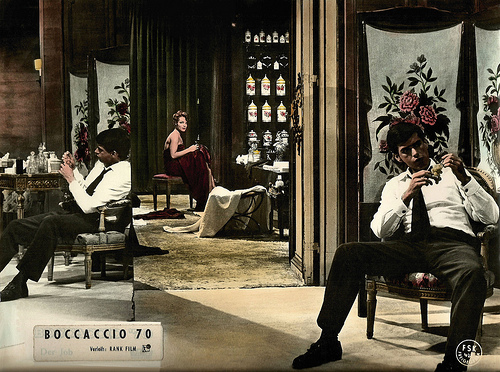
Publicity still distributed by Rank in Germany (see the mark of the German censor FSK at the right). Thomas Milian and Romy Schneider in Luchino Visconti's episode Il Lavoro in the episode film Boccaccio 70 (1962). Milian plays a bored aristocrat, caught in a scandal with callgirls. Schneider plays his rich and equally bored Austrian wife, who tries to seduce her husband and make him pay for love just like he did with his callgirls. It works, but leaves the woman with bitterness. The set of the film was very costly because of all the authentic, valuable objects present.
An Unexpected Boost
After five years of making what he deemed ‘intellectual’ films, Tomas Milian was unhappy with his contract with producer Franco Cristaldi and thought of going back to the United States.
Needing money to start over, he took the opportunity to star as a bandit in the Spaghetti Western El precio de un hombre/The Bounty Killer (Eugenio Martin, 1966). This Spanish-Italian production gave his career an unexpected boost, and ultimately resulted in his staying in Italy.
His next Western was La resa dei conti/The Big Gundown (Sergio Sollima, 1966) with Lee Van Cleef. According to Wikipedia it falls in to the subgenre called Zapata Westerns: Spaghetti Westerns with some political context usually concerning the Mexican revolution.
Milian played Cuchillo, a charming rogue accused of rape and murder. He played the role again in Corri, uomo, corri/Run, Man, Run! (Sergio Sollima, 1968) with Gian Maria Volonté. Milián became a star of the Spaghetti Western genre.
Among his films are the brutally violent Se sei vivo spara/Django Kill (Giulio Questi, 1967), Sentenza di morte/Death Sentence (Mario Lanfranchi, 1968) starring Richard Conte, and Vamos a matar, compañeros/Compañeros (Sergio Corbucci, 1970) with Franco Nero .
Milian often played Mexican bandits or revolutionaries, roles in which he spoke in his real voice. When the Spaghetti Western dwindled, Milián remained a star. He starred in the drama I cannibali/The Cannibals (Liliana Cavani, 1970), inspired by the Antigone of Sophocles.
He had a supporting part in Dennis Hopper’s The Last Movie (1971), which won the Critics Prize at the Venice Film Festival, but failed financially and critically. More successful was the Giallo Non si sevizia un paperino/Don't Torture a Duckling (Lucio Fulci, 1972) in which he starred with Barbara Bouchet.
Milian also excelled in another genre, the Poliziotteschi (Italian police crime films). His first film in this genre Milano odia: la polizia non può sparare/Almost Human (1974) lead to five more films with the director, Umberto Lenzi.
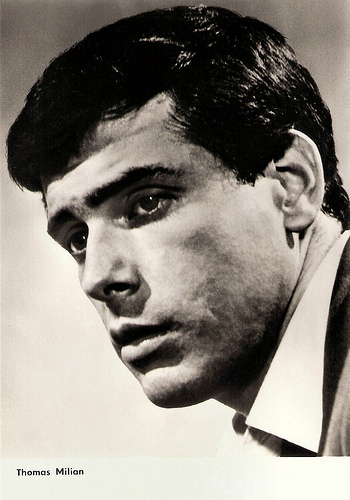
East-German card by VEB Progress Film-Vertrieb, Berlin, no. 2371, 1965. Retail price: 0,20 MDN.
Cult Performer
In the late 1970s, Tomas Milian turned to comedy. In Il trucido e lo sbirro/Free Hand for a Tough Cop (Umberto Lenzi, 1976), Milian played for the first time the petty thief Sergio Marazzi aka ‘Er Monnezza’, a role that he later played two more times.
Another recurring character was the Serpico-like police officer Nico Giraldi, which he played in 12 crime-comedies. Although his voice was dubbed most of the time by Ferruccio Amendola, Milian wrote his own lines in Roman slang. Milián's inventive use of romanesco (roman dialect) made him somewhat of a cult performer in Italy, even though his later films were critically panned.
Wikipedia cites Bruno Corbucci, the director of many of these films: "At the cinemas as soon as Tomás Milian appeared on the screen, when he made a wisecrack and in the heaviest situations, then it was a pandemonium, it was like being at the stadium."
As Milian used similar make-ups and accents in portraying both characters, Monnezza and Nico were occasionally confused by Italian audiences. In Italy, Milián is now still associated with these performances.
Occasionally he appeared in non-genre pictures, such as Bernardo Bertolucci's La Luna/Luna (1979), for which he won a Nastro d'Argento for Best supporting Actor, and Michelangelo Antonioni's Identificazione di una donna/Identification of a Woman (1982). In the latter, Milián plays a divorced middle-aged filmmaker searching for a woman to play the leading role in his next film, and also in his life. The film was awarded the 35th Anniversary Prize at the 1982 Cannes Film Festival.
During his 30 years in Italy, Milian received two major awards for his contribution, the Antonio de Curtis Award for Comedy and the Coppa Del Consiglio Dei Ministri from the Italian government. In 1989, he decided to go back to the United States.
He played character parts in Revenge (Tony Scott, 1990), Amistad (Steven Spielberg, 1997) and Traffic (Steven Soderbergh, 2000). He also performed on stage. More recently he appeared in Andy Garcia’s Cuban drama The Lost City (2005), and in the political thriller The Feast of the Goat (Luis Llosa, 2006), based on Mario Vargas Llosa's novel about the assassination of Dominican dictator Rafael Leonidas Trujillo.
Tomas Milian died in Miami, Florida, where he had lived in retirement. Since 1964, he was married to Rita Valletti. They had one son, Tommasso. Milian was 84.
Trailer Faccia a faccia/Face to Face (Sergio Solima, 1967). Source: Cultcinedotcom (YouTube).
Trailer Roma a mano armata/The Tough Ones (Umberto Lenzi, 1976). Source: Thomas Crommentuyn (YouTube).
Trailer Identificazione di una donna/Identification of a Woman (1982). Source: Tomas Milian (YouTube).
Sources: Sandra Brennan (AllMovie), Tom B. (Westerns... All’ Italiana), The Spaghetti Western Database, Wikipedia and .

Italian postcard by Rotalfoto, Milano, in the series Artisti di sempre, no. 118.
Eyewitness
Tomas Milian was born as Tomás Quintín Rodríguez in Havana, Cuba in 1933 (some sources say 1932). His name is also written as Tomás Milián and Thomas Milian.
He is the son of Tomas Rodriguez, a general serving the dictatorship of Gerardo. His father was arrested and jailed after dictator Fulgencio Batista took power in Cuba in 1933. Rodriguez committed suicide in 1945 in his home, with Tomás as an eyewitness.
In 1955, Milian decided to leave Cuba. Arriving in Miami he worked in several small jobs. He joined the navy for a few months to get his American citizenship.
In New York he auditioned at the Actors Studio, where he was taught the seminal ‘Stanislavsky method’ of acting. He played on Broadway in Maidens and Mistresses at home at the Zoo. Author Meade Roberts had written the piece just for him. Milián also appeared on the short-lived television series Decoy in 1957.
In 1958 he went to Italy for a part in the play The Poet and the Muse by Jean Cocteau, which was performed at a theatre festival in Spoleto. There he decided to relocate, and he stayed in Italy for 30 years.
His Italian film debut was as a young Roman criminal in the social drama La notte brava/Bad Girls Don't Cry (Mauro Bolognini, 1959) with Rosanna Schiaffino and Elsa Martinelli . With Bolognini, he also worked on Il bell'Antonio/Handsome Antonio (Mauro Bolognini, 1960) with Marcello Mastroianni and Claudia Cardinale . The film won the Golden Leopard at the Locarno International Film Festival.
Milian appeared in other classic art house films such as I Delfini/The Dauphins (Francesco Maselli, 1960) starring Claudia Cardinale , and Luchino Visconti’s part of the anthology film Boccaccio '70 (1962), opposite Romy Schneider . In most of his Italian films, his voice was dubbed due to his accent. Milian performed his lines in Italian. Gradually he became a very successful performer in the European cinema.

Publicity still distributed by Rank in Germany (see the mark of the German censor FSK at the right). Thomas Milian and Romy Schneider in Luchino Visconti's episode Il Lavoro in the episode film Boccaccio 70 (1962). Milian plays a bored aristocrat, caught in a scandal with callgirls. Schneider plays his rich and equally bored Austrian wife, who tries to seduce her husband and make him pay for love just like he did with his callgirls. It works, but leaves the woman with bitterness. The set of the film was very costly because of all the authentic, valuable objects present.
An Unexpected Boost
After five years of making what he deemed ‘intellectual’ films, Tomas Milian was unhappy with his contract with producer Franco Cristaldi and thought of going back to the United States.
Needing money to start over, he took the opportunity to star as a bandit in the Spaghetti Western El precio de un hombre/The Bounty Killer (Eugenio Martin, 1966). This Spanish-Italian production gave his career an unexpected boost, and ultimately resulted in his staying in Italy.
His next Western was La resa dei conti/The Big Gundown (Sergio Sollima, 1966) with Lee Van Cleef. According to Wikipedia it falls in to the subgenre called Zapata Westerns: Spaghetti Westerns with some political context usually concerning the Mexican revolution.
Milian played Cuchillo, a charming rogue accused of rape and murder. He played the role again in Corri, uomo, corri/Run, Man, Run! (Sergio Sollima, 1968) with Gian Maria Volonté. Milián became a star of the Spaghetti Western genre.
Among his films are the brutally violent Se sei vivo spara/Django Kill (Giulio Questi, 1967), Sentenza di morte/Death Sentence (Mario Lanfranchi, 1968) starring Richard Conte, and Vamos a matar, compañeros/Compañeros (Sergio Corbucci, 1970) with Franco Nero .
Milian often played Mexican bandits or revolutionaries, roles in which he spoke in his real voice. When the Spaghetti Western dwindled, Milián remained a star. He starred in the drama I cannibali/The Cannibals (Liliana Cavani, 1970), inspired by the Antigone of Sophocles.
He had a supporting part in Dennis Hopper’s The Last Movie (1971), which won the Critics Prize at the Venice Film Festival, but failed financially and critically. More successful was the Giallo Non si sevizia un paperino/Don't Torture a Duckling (Lucio Fulci, 1972) in which he starred with Barbara Bouchet.
Milian also excelled in another genre, the Poliziotteschi (Italian police crime films). His first film in this genre Milano odia: la polizia non può sparare/Almost Human (1974) lead to five more films with the director, Umberto Lenzi.

East-German card by VEB Progress Film-Vertrieb, Berlin, no. 2371, 1965. Retail price: 0,20 MDN.
Cult Performer
In the late 1970s, Tomas Milian turned to comedy. In Il trucido e lo sbirro/Free Hand for a Tough Cop (Umberto Lenzi, 1976), Milian played for the first time the petty thief Sergio Marazzi aka ‘Er Monnezza’, a role that he later played two more times.
Another recurring character was the Serpico-like police officer Nico Giraldi, which he played in 12 crime-comedies. Although his voice was dubbed most of the time by Ferruccio Amendola, Milian wrote his own lines in Roman slang. Milián's inventive use of romanesco (roman dialect) made him somewhat of a cult performer in Italy, even though his later films were critically panned.
Wikipedia cites Bruno Corbucci, the director of many of these films: "At the cinemas as soon as Tomás Milian appeared on the screen, when he made a wisecrack and in the heaviest situations, then it was a pandemonium, it was like being at the stadium."
As Milian used similar make-ups and accents in portraying both characters, Monnezza and Nico were occasionally confused by Italian audiences. In Italy, Milián is now still associated with these performances.
Occasionally he appeared in non-genre pictures, such as Bernardo Bertolucci's La Luna/Luna (1979), for which he won a Nastro d'Argento for Best supporting Actor, and Michelangelo Antonioni's Identificazione di una donna/Identification of a Woman (1982). In the latter, Milián plays a divorced middle-aged filmmaker searching for a woman to play the leading role in his next film, and also in his life. The film was awarded the 35th Anniversary Prize at the 1982 Cannes Film Festival.
During his 30 years in Italy, Milian received two major awards for his contribution, the Antonio de Curtis Award for Comedy and the Coppa Del Consiglio Dei Ministri from the Italian government. In 1989, he decided to go back to the United States.
He played character parts in Revenge (Tony Scott, 1990), Amistad (Steven Spielberg, 1997) and Traffic (Steven Soderbergh, 2000). He also performed on stage. More recently he appeared in Andy Garcia’s Cuban drama The Lost City (2005), and in the political thriller The Feast of the Goat (Luis Llosa, 2006), based on Mario Vargas Llosa's novel about the assassination of Dominican dictator Rafael Leonidas Trujillo.
Tomas Milian died in Miami, Florida, where he had lived in retirement. Since 1964, he was married to Rita Valletti. They had one son, Tommasso. Milian was 84.
Trailer Faccia a faccia/Face to Face (Sergio Solima, 1967). Source: Cultcinedotcom (YouTube).
Trailer Roma a mano armata/The Tough Ones (Umberto Lenzi, 1976). Source: Thomas Crommentuyn (YouTube).
Trailer Identificazione di una donna/Identification of a Woman (1982). Source: Tomas Milian (YouTube).
Sources: Sandra Brennan (AllMovie), Tom B. (Westerns... All’ Italiana), The Spaghetti Western Database, Wikipedia and .
Published on March 25, 2017 22:00
Paul van Yperen's Blog
- Paul van Yperen's profile
- 13 followers
Paul van Yperen isn't a Goodreads Author
(yet),
but they
do have a blog,
so here are some recent posts imported from
their feed.



